Text
Ask Tea
“Ask Tea”, inspired by the colours and geometric composition used by Impressionists and Abstract Art, I tell the viewers an old-style teahouse still existing in my hometown. Drinking tea, talking about the world is still a way of life in a corner of the ever-changing city. The world is changing so fast, but maybe not for everything, for everyone, for everywhere.
《问茶》系列,受到印象派和抽象艺术所使用的颜色和几何构图的启发,我讲述了家乡仍然存在的旧式茶馆。喝茶问道、谈天说地的生活方式仍旧兴旺在日新月异的都市一角,世界变化地如此之快,但似乎并不是对每件事、每个人、每个地方。
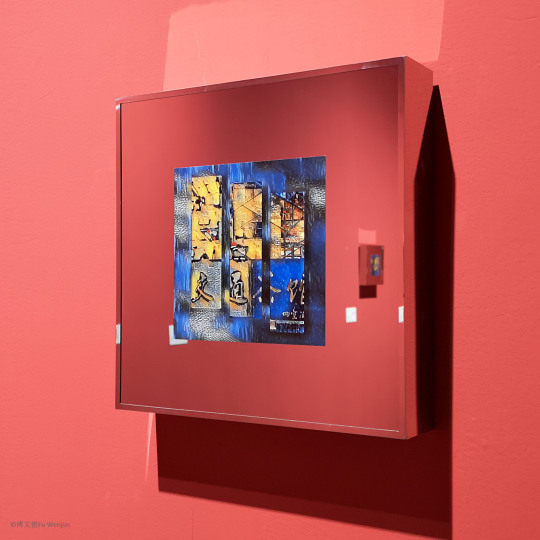
“Ask Tea №1”, Fu Wenjun, Digital Pictorial Photography, mixed media, 30x30cm,2018
《问茶》№1,傅文俊,数绘摄影,综合媒介,30x30cm,2018

“Ask Tea №2, №20”, Fu Wenjun, Digital Pictorial Photography, mixed media, 30x30cm,2018
《问茶》№2,№20傅文俊,数绘摄影,综合媒介,30x30cm,2018
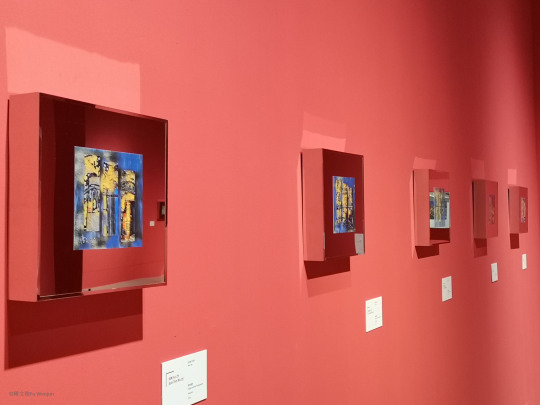
“Ask Tea” installation view, Fu Wenjun, Digital Pictorial Photography, mixed media, 2018
《问茶》展览图片,傅文俊,数绘摄影,综合媒介,2018
#fuwenjun#art#digitalpictorialphotography#digitalart#contemporaryart#chineseart#visualart#history#human#艺术#数绘摄影#历史
0 notes
Text
1980′s
Venice Biennale 2019, entitled May You Live in Interesting Times, pays close attention to the human society with the present tense. Also, in 2019 I create the photography mixed media series 1980’s, which perhaps can be said to cut into the reality from the past, and to introduce the problems that we need to think in a dynamic trajectory.
China in the 1980s was thriving under the policy of reform and opening up. People left the farmland that they had survived on in their hometowns and entered the cities to fight for a better life. Those mottled portraits seem to be the faces of these people who were once confident, and perhaps to be the faces of whom are now old and exhausted. The large-scale population movement that began in the 1980’s has accelerated the construction and development of many Chinese cities. While today, the country has many monotonous and boring urban landscapes filled with high-rise buildings. Cities have too many resources and attract more people to gather. It is getting bigger and bigger, but the resources that each one can be allocated are really limited. In the bustling city, the living space of many people is gradually being squeezed. I witnessed the 1980s, and I am also one look on and reflect, but I don’t know where the future will push us into.
2019年威尼斯双年展以“愿你生活在有意思的时代”为主题,以现在时态关注当今的人类社会。同样在2019年,我创作了这组摄影综合媒介系列作品《80年代》,或许可以说是从过去切入现实,以动态的轨迹引入需要我们思考的问题。
80年代的中国在改革开放的带动下生机勃勃。人们离开在家乡赖以生存的农田土地,进入到大城市打拼更优越的生活。那些斑驳的人像仿佛是这些人曾经信心满满的面庞,又也许是他们如今渐已苍老疲惫的容貌。80年代开始的大规模人口流动推动了许多中国城市的建设发展,现在的中国遍布着被高楼大厦填充,千篇一律的乏味城市景观。城市占有了太多资源,吸引力了更多人的聚集,它变得越来越庞大,但能够分配给每个人的资源的确很有限,热闹背后不少人的生存空间正在逐渐被挤压。我是80年代的亲身经历者,也是旁观者,更是思考者,我却不知道未来将把我们推向何处?

“1980’s №1”, Fu Wenjun, Digital Pictorial Photography, mixed media, 50x50cm, 2019
《80年代》№1,傅文俊,数绘摄影,综合媒介,50x50cm,2019

“1980’s №2”, Fu Wenjun, Digital Pictorial Photography, mixed media, 50x50cm, 2019
《80年代》№2,傅文俊,数绘摄影,综合媒介,50x50cm,2019

“1980’s №3”, Fu Wenjun, Digital Pictorial Photography, mixed media, 50x50cm, 2019
《80年代》№3,傅文俊,数绘摄影,综合媒介,50x50cm,2019
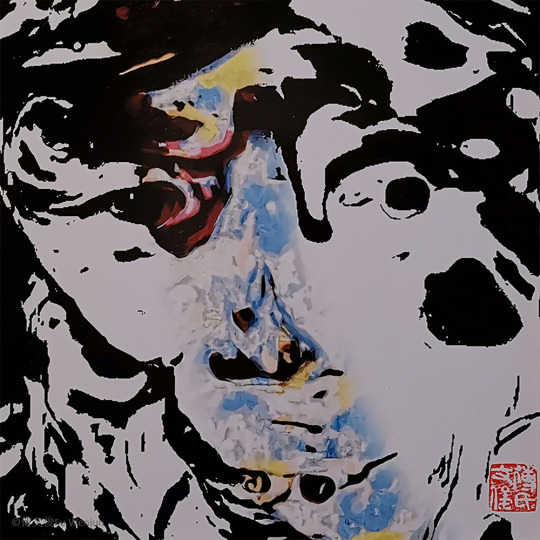
“1980’s №4”, Fu Wenjun, Digital Pictorial Photography, mixed media, 50x50cm, 2019
《80年代》№4,傅文俊,数绘摄影,综合媒介,50x50cm,2019
#fuwenjun#art#digitalpictorialphotography#contemporaryart#chineseart#visualart#hisotry#human#艺术#数绘摄影#历史
0 notes
Text
Harmony in Diversity
Harmony in Diversity can be seen as a variant of A Wind from Yesterday, in which Fu Wenjun replaced the Euphrates poplar with the overlying of Western classic sculptures and Chinese ancient paintings. Then the dialogue between nature and civilization has evolved into the dialogue between Chinese and Western culture. It is evident that they represent two completely different aesthetic ideals: the Western sculptures pursue a perfect form, while the Chinese paintings adore the light and intangible spirit. Nevertheless, with the overlying performed by Wenjun, they do not appear to be inharmonious. In his own special way, the artist interprets the harmony in diversity, which represents a wisdom contributing to the continuous development of Chinese civilization and which can untie the hard knot of culture diversity and clash of civilizations. — — Peng Feng, Professor at Peking University School of Arts and curator of the Chinese Pavilion at the 54th Biennale di Venezia.
“和而不同”系列可以被视为“昨夜西风”系列的变体,傅文俊将胡杨树的照片替换为西方经典雕塑和中国历代名画的叠加。于是,自然与文化的对话,就演变成为中西文化的对话。追求完美形体的西方雕塑与崇尚虚灵气韵的中国绘画,代表两种全然不同的审美理想,但是当傅文俊将它们叠加起来的时候,却没有丝毫违和之感。傅文俊以自己特有的方式,诠释了和而不同。和而不同是中华文明赖以长盛不衰的智慧,今天也只有它才能解开文化多���性与文明冲突之间的死结。 — — 彭锋,北京大学艺术学院教授、2011年威尼斯双年展中国馆策展人
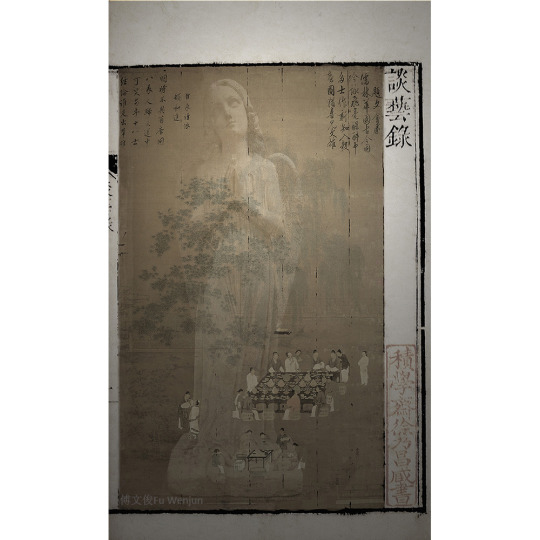
“Harmony in Diversity №1”, Fu Wenjun, Digital Pictorial Photography, 105x180cm ,2016–2017
《和而不同》№1,傅文俊,数绘摄影,105x180cm,2016–2017

“Harmony in Diversity №1”, Fu Wenjun, Digital Pictorial Photography, 105x180cm ,2016–2017
《和而不同》№1,傅文俊,数绘摄影,105x180cm,2016–2017

“Harmony in Diversity №1”, Fu Wenjun, Digital Pictorial Photography, 105x180cm ,2016–2017
《和而不同》№1,傅文俊,数绘摄影,105x180cm,2016–2017
#fuwenjun#art#digitalpictorialphotography#digitalart#contemporaryart#chineseart#visualart#history#艺术#数绘摄影#历史
1 note
·
View note
Text
Fu Wenjun's Digital Pictorial Photography
Website: www.fuwenjun.com
Email: [email protected] / [email protected]
Fu Wenjun’s creative output can be summed up by his term Digital Pictorial Photography, which he uses to redefine the traditions found at the core of the photographic arts. By demonstrating the complementary relationship of photographs and other modes of artistic practice, Fu Wenjun transforms what may seem to be an inaccessible message into a highly approachable concept that can trigger critical thought about history and humanity.

Neighbors, Fu Wenjun, Digital Pictorial Photography, 140x1200cm 2009

Illusory Metamorphosis No.8, Fu Wenjun, Digital Pictorial Photography, 110x140cm, 2009-2011

Thought Reading No.2, Fu Wenjun, Digital Pictorial Photography, 110x140cm 2009-2011
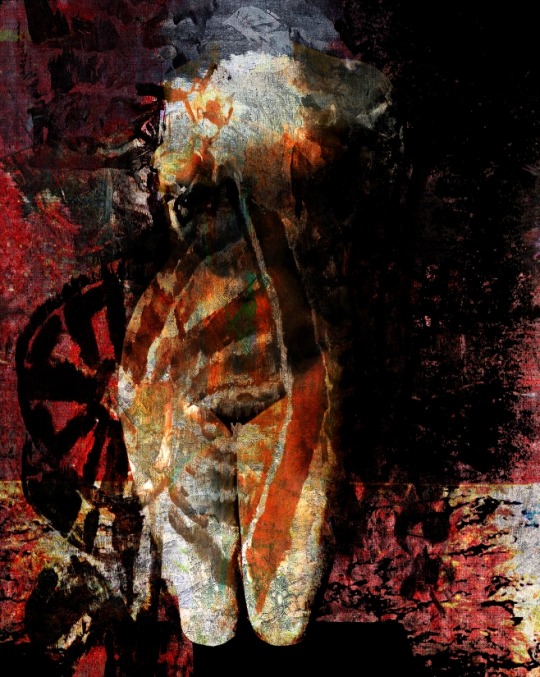
350 B.C., Fu Wenjun, Fu Wenjun, Digital Pictorial Photography, 140x175cm, 2014-2015

Food Is the God of People, Fu Wenjun, Digital Pictorial Photography, 140x175cm, 2014-2015

Among the Clouds, Fu Wenjun, Digital Pictorial Photography, 140x175cm, 2014-2015

June Snow, Fu Wenjun, Digital Pictorial Photography, 100x100cm 2017-2018
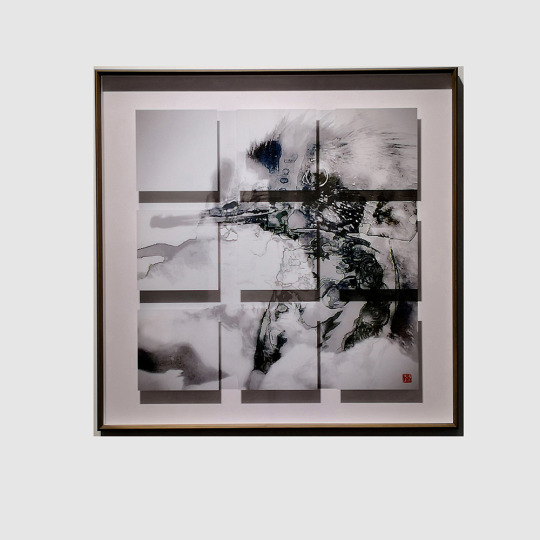
Crying Osprey, Fu Wenjun, Digital Pictorial Photography, 100x100cm 2017-2018

Dubai Fish, Fu Wenjun, Digital Pictorial Photography, 100x100cm 2017-2018
EXHIBITIONS
2019, “Digital Brush: The Photographic Process of Fu Wenjun”, The University of Hong Kong, Hong Kong, China;
2018, “Is It Photography – Fu Wenjun Digital Pictorial Photography Solo Exhibition”,
Dairy Arts Center, Boulder, USA;
2017, “Introspection of Soul. Artistic Expression in the Digital Pictorial Photography of Wenjun Fu”, Museu Europeu de Arte Moderno, Barcelona, Spain;
2017, “Harmony in Diversity --- Fu Wenjun’s Digital Painting Photography Exhibition”, National Art Museum of China, Beijing, China;
2017, Esposizione Triennale di Arti Visive a Roma, Complesso del Vittoriano, Rome, Italy;
2017, London Art Biennale, Chelsea Old Town Hall, London, UK;
2015, “Thoughtful Images --- Fu Wenjun’s Abstract Photography Exhibition”, Guangdong Museum of Art, Guangzhou, China;
2015, XVIII Bienal de Cerveira, Forum Cultural, Vila Nova de Cerveira, Portugal;
2015, Nord Art 2015, Kunstwerk Carlshütte, Büdelsdorf, Germany;
2013, Voice of the Unseen Chinese Independent Art 1979/Today, collateral exhibition of Venice Art Biennale 2013, Arsenale, Venice, Italy.
AWARDS
2012, International Excellent Art Prize, World Chinese Arts General Meeting, China;
2014, First Prize of Digital Art of the 2nd International Biennial of Contemporary Art in Argentina, International Biennial of Contemporary Art in Argentina, Argentina;
2015, International Award “Lorenzo il Magnifico” of X Florence Biennale, Florence Biennale, Italy;
2016, “Visitors Chosen Artist” at Triennale dell’Arte Contemporanea, Triennale dell’Arte Contemporanea, Italy;
2018, Digital Art winner of Best Global Artist Awards, Global Art Awards, UAE.
PUBLICATIONS
2018, “Catalogo dell'Arte Moderna No.54”, Cairo Publishing, Italy;
2018, “Art Comes from Life”, Enid Parker, Khaleej Times – City Times 19April, 2018, the United Arab Emirates;
2018, “Carefully Managed Image: Photo Artist Explores Abstract Concepts to Create 3D Sculpture”, Deng Zhangyu, China Daily 1 July, 2018, China;
2017, “Fu Wenjun, fotografia e tradizione cinese”, Daniela Malabaila, BIANCOSCURO, Italy
2017, “Fu Wenjun, A Wind from Yesterday”, Clive Waring, Silvershotz, Issue April 2017, USA;
2016, “International Contemporary Masters XII”, Despina Tunberg, Thomas Tunberg, World Wide Art Books, the USA;
2015, “Most Important Modern and Contemporary Artists”, Salvatore Russo, EA Editore, Italy;
2013, “The Wiser’s Game, An Interpretation of New Works by Fu Wenjun”, Fu Wenjun, Art Gallery Magazine Issue 180, China.
RESIDENCY
2019, Swatch Art Peace Hotel, Shanghai, China.
SOCIAL MEDIA
Instagram: https://www.instagram.com/fu_wenjun/
Facebook: https://www.facebook.com/fuwenjunstudio/
Twitter: https://twitter.com/FuWenjunStudio
CONTACT
Website: www.fuwenjun.com
Email: [email protected] / [email protected]
0 notes
Text
Daily Art Magazine: A Feeling of Nostalgia, Art by Fu Wenjun

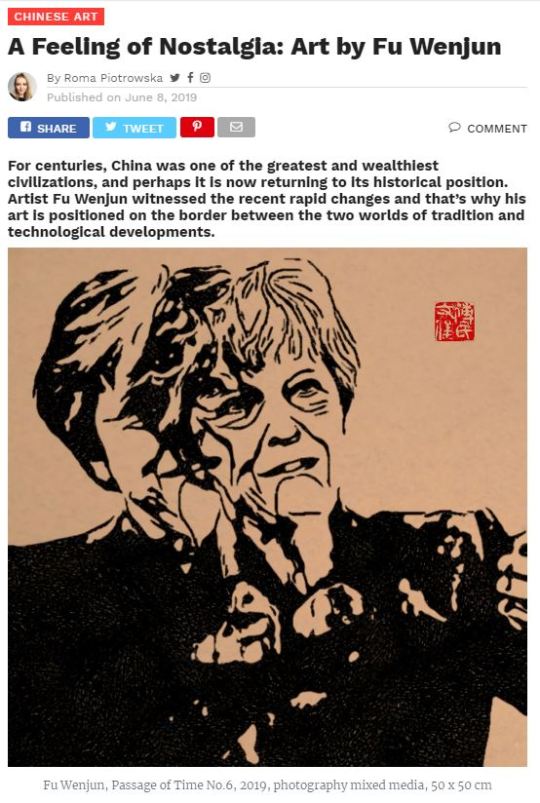
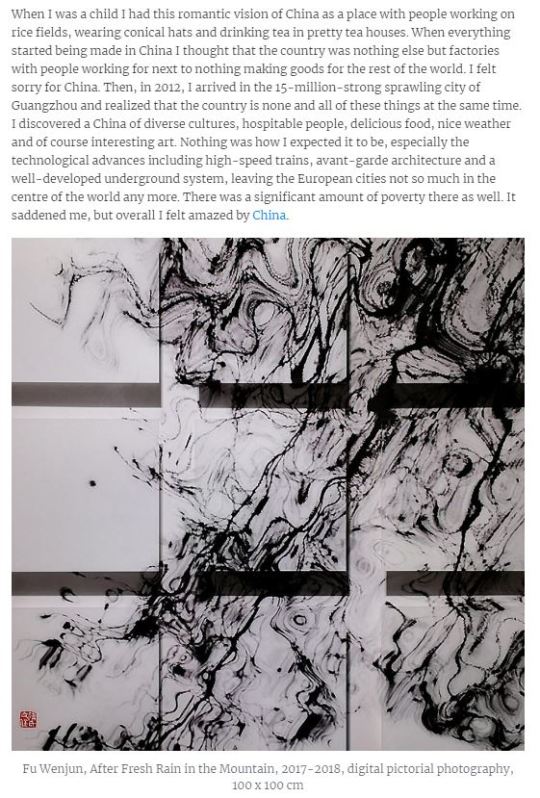



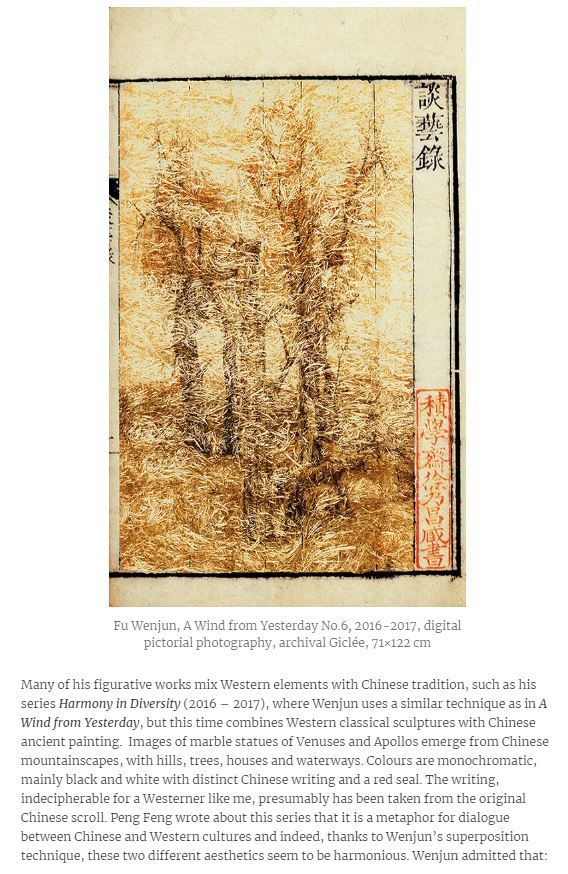

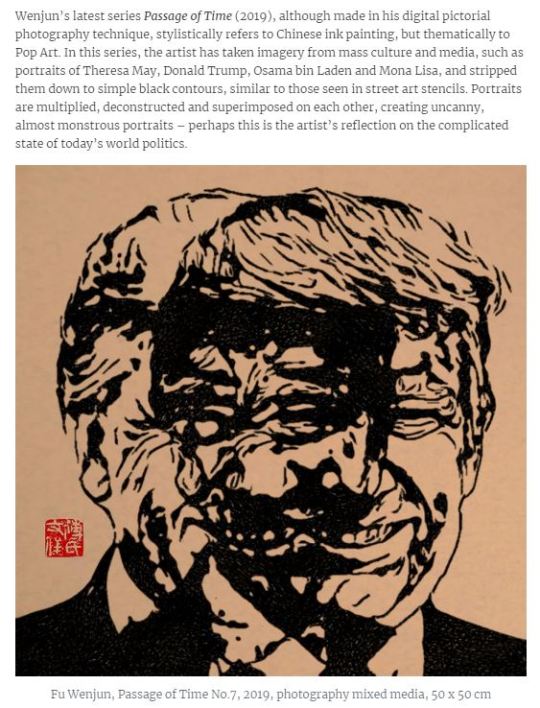


#fuwenjun#mixedmedia#photography#fineartphotography#digitalpictorialphotography#contemporaryart#chineseart#inkart#artist
0 notes
Text
人世间,以肉眼视看——谈当代艺术家傅文俊的“数绘摄影”
文 / 陆颖
即便融合了数绘技术与装置,傅文俊的“数绘摄影”作品,依然是对人世间的肉眼视看,因其在技术背后,直指普世的人与人的生存,带有浓烈的人文主义精神与存在主义观照。从早年的纪实摄影发展而来,数绘摄影艺术巧妙地游走于“无为有处有还无”的图像边界,在媒介跨越与拓展的同时,完成了从“实象”走向“幻象”进而复归“实象”的往返,并由此实现了对传统摄影作品观看方式的变革。
(一)有意味的东方形式
傅文俊的作品体现出抽象表现主义的形式突破,从世界各地取材而来的图像,更贴近生活本身,书写着整个人间大地上的诗意,相较于其他观念艺术,显得亲切与质朴。傅文俊善于从历史的宏观视角来处理东方传统文化元素,雅致且有余韵,这一点尤其体现在作品名称上。如作品《小楼昨夜又东风》,具象的“小楼”、“东风”意象将抽象的线条与色块渐变拉回人世之间,在“图像”与“文字”之间架构起艺术通感的桥梁,提供可能的作品主题解释。尽意莫若象,尽象莫若言,图文之间彼此贴合、相辅相成。

《小楼昨夜又东风》傅文俊数绘摄影2017-2018
“有意味的形式”理论由英国文艺批评家克莱夫·贝尔(Clive Bell)提出,并称其为“一切视觉艺术的共同形式”,即视觉艺术作品通过线条、色彩或某种特殊的形式与形式之间的关系,来激发观看者的审美感情。傅文俊的作品是对“有意味的形式”的有效实践,却并不仅限于此。在对图像的复制、拼贴、挪用、重新赋义之余,“食色”、“问茶”、“F1”、“唯马首是瞻”等系列主题作品,将抽象图像的离心力拉回并作用于现实,呈现出跨文化语境之下的“有意味的东方形式”。

《问茶No.1》傅文俊数绘摄影 2018
(二)剧场假象与艺术通感
对二维平面的突破是以装置的形式实现的。装置(突出于画面的小方块)将平面摄影裂变为三维空间,形成视觉前景与背景,形成图像符号的同构性与异质性。美国艺术史家迈耶·夏皮罗(Meyer Schapiro)将抽象艺术中的非拟态因素(non-mimetic elements)视为形式分析的要素,认为由背景、边框、位置/比例与视觉透视形成的形式调整能够形成不��的视觉密度或视觉张力,这直接决定了对视觉图像作品的解读。在傅文俊的作品中,当前景图像与背景图像彼此脱离(同时彼此粘连)后,很难说清是背景衍生出前景,还是前景连带出背景。在突破二维图像的形式框线后,装置作品呈现出剧场性(theatricality)特征,装置的剧场性特征使观看者凝视图像的过程中,进入图像叙事的场域,拓展了作品解读的可能性与开放性,更能引发观看者的审美共情。

《坐看云起时》傅文俊数绘摄影 2017-2018
由此,我们便不难分析这些数绘作品中的主观性艺术通感,傅文俊在不同艺术门类触类旁通之余,通过具体图像的表象联想、转化和移用,有感于物、有悟于心,使作品呈现出动态的平衡与和谐。以作品《坐看云起时》为例,这种协和统一体现在多方面:1.数绘图像如同水墨画般的层次感与线条的动态视效;2.作品的装置性呈现出剧场化的空间感;3.诗句“坐看云起时”一句中“起”字的妙用带给人动态联想。如此多方合力,引发了观看者在欣赏作品时的“联觉”与共情,艺术家自身的艺术通感得以完美地作用于艺术欣赏者。
(三)作为图像行为的摄影
摄影是一项具有被动性和介入性的艺术,通过镜头介入外界与他者。数绘摄影将传统纪实性摄影的相对被动,转化为绝对的主观能动,从艺术创作角度来看,这是傅文俊数绘摄影对传统摄影的根本革新所在。装置和形式在艺术创作和欣赏过程中,其实极易流于表面而无从深究,观看傅文俊的作品时,却依然能够强烈感受到镜头背后,艺术家意欲言说的开放性话语。
我更愿意将跨媒介的模糊性作品视为图像行为,作品本身试图言说的,正是观看者在读图过程中能够切实感受到的“述行性”(performative,或曰施为力),图像不再是被动的被观看,而是成为行为力量的施加者,主动与观看者对话。傅文俊的作品亦是如此,它们向观看者发出进入场域的邀请,与观看者共同在一个图像符号建构的剧场中共舞。这大概就是跨媒介视觉艺术的魅力所在吧。
关于作者: 陆颖,文艺学博士、青年批评家、浙江师范大学文化创意与传播学院教师
0 notes
Text
Analysis on Chinese Contemporary Artist Fu Wenjun Digital Pictorial Photography
by Mao Qiuyue
Chinese contemporary artist Fu Wenjun proposed digital pictorial photography in the early 21st century. [1] Digital pictorial photography is a combination of painting elements through digital post-adjustment and multiple-exposure photographic images to reveal unique visual effects. It emphasizes the rediscovering and reuse of image resources.

April, Fu Wenjun, Digital Pictorial Photography, 100x100cm, 2017-2018
How does Fu Wenjun create his works?
Fu Wenjun once summed up his creative means as such: “My concept will be expressed by means of collage, juxtaposition, etc.” [2] Collage is to integrate elements which are not related to each other, thus having an effect of challenging people’s stylized cognition. Juxtaposition is the act or an instance of placing two or more things side by side, often to compare or to create an interesting effect. Collage and juxtaposition are important methods in western modern and contemporary art. They were initiated by the masters of early 20th century modern art such as Pablo Picasso and Gorge Braque, culminating in the hands of postmodern artists such as Robert Rauschenberg and Andy Warhol. However, the difference is that the post-modern juxtaposition of Western art largely cancels oppositions, while Fu Wenjun sharpens the opposition between different items, thus creating a tension on the two-dimensional surface.

Crying Ospresy, Fu Wenjun, Digital Pictorial Photography, 100x100cm, 2017-2018
Where does the artist’s intellectual resources come from?
Fu Wenjun’s creative thinking reflects the combination of the East and the West. In Fu Wenjun’s artworks, some characteristics of Chinese traditional art are very prominent, such as the conflict between cavalier perspective and focus perspective, the interpenetration of ink smudges and colors, and the organic combination of vividness and subjective expression. While getting rid of the shackles of documentary photography, Fu’s digital pictorial photography captures Chinese ink painting elements, embodying a touch of freehand brushwork. Fu often likes to reflect on Chinese tradition, history and religion in his works, such as Twelve Zodiac, A Wind From Yesterday, Ask Tea, East Wind Blew Again Last Night, etc. [3] This is a way of bringing history back to the present on one hand, and emphasizing the impact of modern lifestyle on Chinese tradition on the other hand.
Fu Wenjun integrates the essence of modern and contemporary art such as Dadaism, Abstract Expressionism, conceptual art and pop art. His digital pictorial photography shows a modernist sense of homogeneous space with postmodernist collage techniques. The so-called “homogeneous space” refers to the fact that since Edward Manet, modernist paintings have deconstructed the three-dimensional surface, abandoned the story-telling genre and revealed a two-dimensional effect, which finally culminated in Jackson Pollock’s all-over paintings. [4] According to many art historians, modernism have been moving toward abstraction, but this is not a deliberately designed route. Such trend has exerted a strong influence on later artworks.

Gondola's Waiting I, Fu Wenjun, Digital Pictorial Photography, 60x60cm, 2017-2018
Fu Wenjun uses a variety of media deftly. Rosalind Krauss once pointed out that artworks after the modernist paintings have greatly broadened the connotation of “medium”. A medium can be something solid, or it can be a behavior itself. In other words, artists’ medium is no longer restricted to specific things; it exists in the field of communication with the audience.[5]
As an artist living in the southwestern province of China, Fu Wenjun has been trying to show the collision between traditional national culture and contemporary culture, which is an important theme in his works. The subtlety and the subjects reflect Fu Wenjun’s oriental background, and his artworks show a spiritual lineage to the West.

Orderly Disorder, Fu Wenjun, Digital Pictorial Photography, 60x60cm, 2017-2018
How to understand Fu Wenjun’s abstraction?
To explore the possibility of abstraction is Fu Wenjun’s another concern. It is more than a pure formal question. The abstraction in digital pictorial photography is similar to the “semantic abstraction” proposed by British scholar Harold Osborne, that is, “incomplete or limited reproduction of natural appearance.” [6] This technique allows the author to give full play to his personality and imagination. The images in Fu Wenjun’s works are distilled either from the real world or from other works of art.
Abstraction is a method for the artist to understand the world. It does not mean being out of touch with reality. Free from objective representation, the artist reshapes the world for expressive purposes. In Fu Wenjun’s work, images that people take for granted are broken up and then rearranged, allowing the audience to see the world through the artist’s eyes and then to think differently. In these works, both abstraction and reproduction are not purposes, but means.
Modern scientific research has shown that people’s understanding and appreciation of abstract elements in artworks are deeply rooted in their basic cognitive abilities, and abstraction is not too high to be popular.

Human Nature for Food No.1, Fu Wenjun, Digital Pictorial Photography, 60x60cm, 2017-2018
What does the artist want to tell us through his work?
Fu Wenjun is committed to showing the interaction of different things. Based on photography, his works explore many possibilities of artistic expression. The works of art that we have seen today have more or less abandoned the shackles of a large amount of substantive content in reality. The artist uses documentary materials as his basis, and incorporate his contemplation on Chinese culture. In recent years, works such as Ask Tea and Red Cherry have become more experimental, which shows that his grasp of the work is getting better and better. [7]
To arouse people’s awareness of art’s critical function is Fu Wenjun’s aim. As Fu said in an interview a few years ago: “Digital pictorial photography is an attempt to propose some meaningful topics through the medium of photography. I hope it will lead people to think deeper. Everyone will have his/her own understanding. There is no definite answer.” [8] Fu Wenjun believes that contemporary art is critical, and it is not a game of speculation and recreation. The responsibility of contemporary artists is trying to reveal and analyze problems by their sharp perception and perspectives. Fu Wenjun takes many pictures in his travel and uses them as his raw materials. After coming back to his studio, he will tear, split and recombine the images, while being unaware of the restriction of time and space. In a word, he aims to make a clear and rational critique on this complex world.
About the author: Mao Qiuyue,Post-doctoral Researcher of Zhejiang University; Assistant Professor of Tongji University
References:
[1] https://en.wikipedia.org/wiki/Fu_Wenjun.
[2] https://news.artron.net/20130124/n303842_1.html,《远古故事与当代寓言:傅文俊谈<图腾>系列创作》,2013-1-23.
[3] http://en.fuwenjun.com/index.php?c=content&a=list&catid=73.
[4] See Clement Greenberg, Art and Culture, Boston: Beacon Press, 1961.
[5] See Rosalind Krauss, The Originality of the Avant-Garde and Other Modernist Myths. Cambridge, Massachusetts: MIT Press, 1985.
[6] See Harold Osborne, Abstraction and Artifice in Twentieth-Century Art, Oxford: Oxford University Press, 1979.
[7] https://www.ny-artnews.com/single-post/2018/12/14/Fu-Wenjun’s-Digital-Pictorial-Photography, Grishma Khodaria, “Fu Wenjun’s Digital Pictorial Photography”, 2018-12-15.
[8] https://cul.qq.com/a/20130923/016589.htm, 《傅文俊:真正的艺术家不会为商业妥协》,2013-09-24.
1 note
·
View note
Text
Fu Wenjun Solo Booth Show at 2019 The Photography Show Presented by AIPAD

International gallery BOCCARA ART presents a solo booth show of Chinese artist Fu Wenjun's Digital Pictorial Photography works at The Photography Show organized by AIPAD (Association of International Photography Art Dealers), April 3-7, Pier 94, New York City.
Fu Wenjun’s creative output can be summed up by his term Digital Pictorial Photography, which he uses to redefine the traditions found at the core of the photographic arts. By blending elements of other artistic media into the process, he creates a brand-new form of aesthetic pleasure. Fu Wenjun embraces a range of art forms, combining them into unique and monumental works that reach beyond the mere act of recording a photographic image.
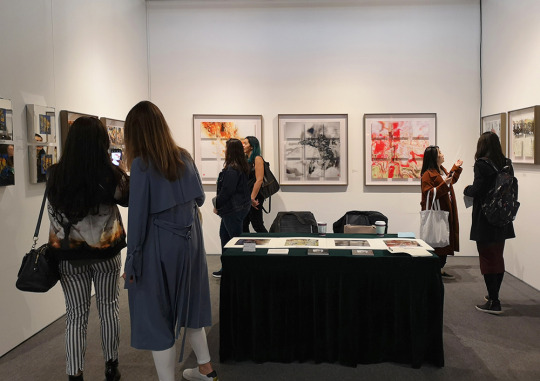
Works on view are from four series of Fu Wenjun’s Digital Pictorial Photography: “Misplacement”, “Ask Tea”, “F1”, “Human Nature for Food”. His work brings together the practical aspect of photography with the aesthetic nature of other forms of visual arts. By demonstrating the complementary relationship of photographs and other modes of artistic practice, Fu Wenjun transforms what may seem to be an inaccessible message into a highly approachable concept that can trigger critical thought about history and humanity.
In terms of photography art, Fu Wenjun believes “Photography is two-dimensional. But if we fall into this definition, our expression with photography would be limited. In my works I integrate many personal understandings of Chinese traditional art… Some people say my works “do not look like photography”, but the “unlike photography” on the contrary is a new way of presentation. We could change anything and make changes beyond the common sense.”

The New York Times reported in the article "18 Art Exhibitions to View in N.Y.C. This Weekend", saying "Boccara Art from Brooklyn, which is displaying striking conceptual pieces by the Chinese contemporary artist Fu Wenjun." (https://www.nytimes.com/2019/04/04/arts/design/nyc-this-weekend-art-and-museums.html)

ARTNET in its report "Discover 6 Must-See Booths at AIPAD's Photography Show" features "the multimedia work of Chinese contemporary artist Fu Wenjun encompasses installation art, photography, and oil painting. For AIPAD, international gallery Boccara Art highlights works from the artist’s 'digital pictorial photography' series, which—in boldly colored displays—abstractly evoke natural landscapes." (https://news.artnet.com/partner-content/photography-booths-aipad-2019)

Professors from School of Visual Arts guided their master students to the booth and talked with the artist about his art creation and ideas.
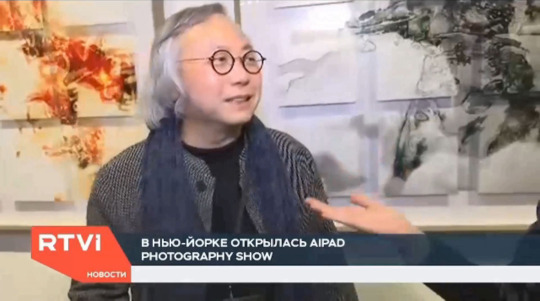
RTVI, New York-based television network hosted a live report at the booth, having interviewed the gallery owner and introduced Fu Wenjun's Digital Pictorial Photography works to its audience.
0 notes
Text
ART511MAG: Fu Wenjun is a must-see artist at this year’s AIPAD
Fu Wenjun Digital Pictorial Photography
BY ART511 STAFF
Chinese artist Fu Wenjun premiers new work in a solo booth at this year’s Photography Show at Pier 94. In its 39th edition and the longest running institution of its kind, The Photography Show presented by AIPAD (Association of International Photography Art Dealers) showcases work by lead contemporary artists represented by U.S., European, Asian, Canadian, Mexican, Middle Eastern and South American galleries, in addition to book dealers and publishers. Boasting “exceptional photography from the world’s top fine art photography galleries,” the coinciding AIPAD Talks invite prominent curators, artists, collectors, and writers into roundtable discussion around the medium’s latest trends, processes and critical thought. Contemporary, modern and 19th-century photography is exhibited alongside photo-based art, video, fashion photography and new media.
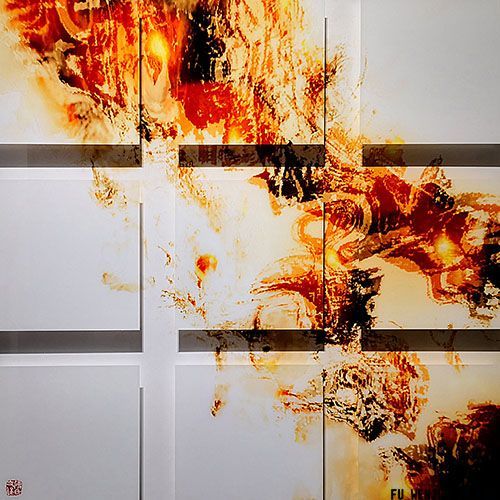
Red Cherry
Born in 1955, Chinese contemporary artist Fu Wenjun is principally a photographer, but also works in the realms of installation, sculpture and oil painting. With a lengthy museum exhibition history, Wenjun has been honored with numerous awards, including “The Best Artist in the World” at Tour Eiffel La Grande Exposition Universelle. The artist returns to New York City this April currently framing his practice and the work presented at The Photography Show around his concept “Digital Pictorial Photography.” Wenjun’s work naturally evades any singular label. Having graduated from the Sichuan Fine Arts Institute, his abstracted photographs integrate the artist’s personal understanding of Chinese traditional art. “There was a period that I was keen on the shooting skills to produce ‘good’ documentary photography,” says Fu. Said skills are the current basis for his work pushing the limits of 2-dimensionality. Many of his image compositions among the recent series surely elude the definition of photography entirely.
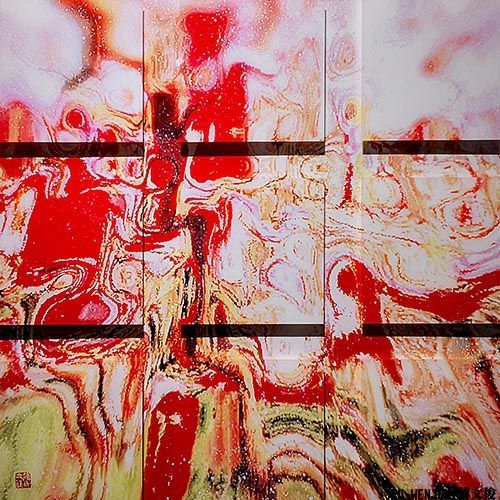
April
As the AIPAD Talks are keen to acknowledge, the genre is rapidly changing, with miracles of technology, image manipulation, staged and performance photography, materiality, process, and playing with “chance” all having earned recognition as acceptable modern approaches. In Stephen Shore’s scheduled artist talk with critic Lynne Tillman, the pair inquires “Is there pressure to communicate in ways less mediated by convention and genre?” God knows artists need mediums like bats need the sun, but art writing uses words, and words drive the brain. Fu Wenjun maintains that the fact that his photos don’t look like photos is an intentional form of presentation in and of itself. He intends to keep pushing the medium with increasingly diverse forms of presentation. Wenjun provokes us to move beyond common sense, and moreover, to place photography in dialogue with more traditional mediums like Chinese painting, oil painting and sculpture. Through this lens, insists Wenjun, we can expand the boundary of contemporary photography and perhaps, our own vacillating but virtually pinhole perspective on reality.
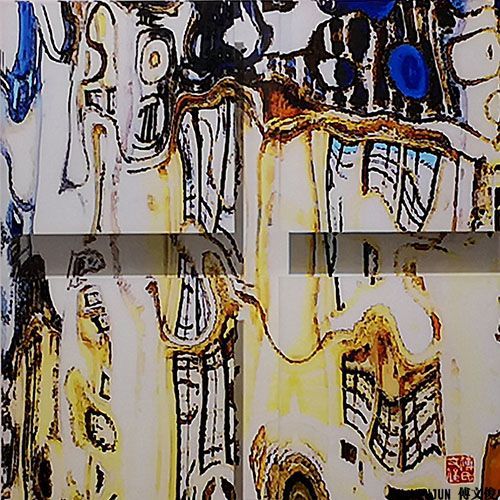
Orderly Disorder
Several in his Digital Pictorial Photography series will be on view at Pier 94 this year. Some pieces depict abstracted objects of quotidian daily life — what appears to be a calculator or tea kettle — other objects are nestled into themselves, their total forms gracefully obscured. Ever at play with the formalities of painting, and even fine art — the artist excels in segmenting out his images into virtual diptychs or triptychs, or for instance, isolating figures as discrete objects on pedestals that are themselves equally alive with swirls and strokes. “Human Nature for Food,” interrogates our relationship to what is most delicious in life. Wenjun goes as far as to say the piece is about juxtaposing the beauty and ugliness inherent to the human experience, that which is of course found inside and out.

Human Nature for Food No.1
His digital medium leaves few barriers to behold, as if combing through the psyche with a fine-tooth instrument, exposing human nature, leisure activities and spectacle culture in all its banal fascination. His painting “F1” invokes Formula 1? raceway fury, a peak cultural moment the artist explains is both “real and illusory,” bloated with expectation and at the same time, in defiance of it. Some photos arrive fast with bold, almost painterly strokes; others fade out into ethereal mist, where pixelation invokes pointillism. Some envelope themselves in so much white space our conditioned mind is eclipsed by the artist’s rhythmic politics of dislocation and assimilation. Grid lines, frames and screens further dissect the canvas – playing upon the viewer’s retina with their graphic intentionality. With a reckless eye for the new, Wenjun excels equally into abstract chaos and vignette – eruptions, splatters, gore, household decor, a freeze frame of that edge-of-your-seat sporting event all fit into neat compositions marked by the artist’s linear framing devices. Wenjun’s “Ask Tea,” inspired by the color and geometry of Impressionism and Abstraction, reminisces on an old-style teahouse still existing near the artist’s hometown. “The world is changing so fast,” says Wenjun, and although his pieces are curiously outside the bounds of photography, he still sees it the most fit medium to capture our rapidly evolving world.

Ask Tea No.2
With the traditional canon opening unto progressive polycentrism and the tyrannical fiction of white western superiority eroding, questions of representation in the arts aggress open fire on the status quo. Although Wenjun’s photos are abstracted, and naturally almost void of any singular subjectivity, his cultural vantage point as a Chinese man certainly adds layers to his cacophonous aesthetics of discord. As the artist relates, his work is influenced by legacies of the East and West, the effects of globalization and both the urbanization and industrialization of Chinese cities. A seasoned traveler and exemplary global citizen, his works achieve a sort of non-place and non-space that speaks volumes about our shifting relationship to nation, identity and economy.

F1 No.11
Under the surface of his obscured still lives and residues of the abject, Fu’s photography blithely teems with Asian influences. His penchant for dividing or grid-lining the canvas in certain instances may be less a play on the formalities of fine art, than a reflection of traditional Chinese painting. Often presented on long hanging scrolls or series of scrolls or segmented into lacquered panels, eye candy of many a folding screen, wall, archival paper and premium silk, Chinese painting is highly distinguishable from the western tradition of Fine Art. Chinese painting, guóhuà (國畫), is one of the oldest continuous artistic traditions in the world. Holding the meanings “national” or “native painting,” this brush and ink painting style is closer to calligraphy than the western style of painting popularized in China during the 20th century. It is a tradition passed down from master to apprentice. Landscapes have always been considered the highest form of Chinese painting, and generally still are.

F1 No.12
Likewise, Wenjun’s “Misplacement,” alive with vibrant carmine and pale gold, seamlessly translates the aesthetics of classical Chinese ink mastery into contemporary photography. The photograph’s abstract glee, almost verging on pixelation or glitch, invites temporal musings. The where, when, what and how of it all tugs at our sense of nostalgia for times past, our future fears melting away as the painterly photos perform their ablutions. Like a noble sage, Wenjun’s artworks steadily steer us back into the present moment at hand.
Fu Wenjun is a must-see artist at this year’s AIPAD because his “Digital Pictorial Photography” redefines the traditions found at both the core of the photographic and traditional arts, obliterating the divide between East and West in principle, process and practice. Through his new technique, whatever philosophical content at risk of becoming inaccessible within its elite milieu of Fine Art becomes “transformed into a highly approachable concept that can trigger critical thought about history and humanity,” explains Wenjun. Leeching aesthetic pleasure from principle particles past and future, these works orbit the galaxy of complementarity and box in the matrix, expanding our relationship to art, history and humanity.
Checkout Fu Wenjun’s solo exhibition
presented by BOCCARA ART gallery at AIPAD
The Photography Show
April 4 – 7, 2019
Opening Preview: April 3, 2019
Pier 94 | New York City
AIPAD (Association of International Photography Art Dealers) www.aipadshow.com
Fu Wenjun Studio: www.fuwenjun.com
http://art511mag.com/2019/03/20/fu-wenjun-digital-pictorial-photography/
0 notes
Text
AT ART BASEL WITH BIANCOSCURO RIVISTA D’ARTE ISSUE ART BASEL HONG KONG MARCH 2019

Fu Wenjun feature on BIANCOSCURO Issue Art Basel Hong Kong March 2019
BIANCOSCURO at Art Basel Hong Kong
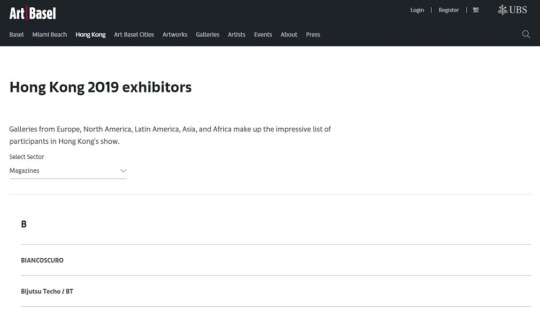
FUWENJUN, NEW HORIZONS FOR CONTEMPORARY PHOTOGRAPHY
"Fu Wenjun embraces a range of art forms, combining them in unique and monumentalworks that go beyond the simple act of recording a photographic image."
Continues in its ascent towards the consecrationin the world of art that counts, undaunted unveils, day after day, new goals of his personal stylistic and conceptual research. Telling Fu Wenjun has never been simple, his works are always simple, clearly and aesthetically perfect, calibrated and harmonious, and precisely this mathematical perfection deceives emotional and investigative perception. The technique he created and used we already know Digital Pictorial Photography, but we cannot stop at technicality, we must investigate thoroughly to understand first what led Wenjun to develop his personal style. Why did he feel the need to merge the different disciplines? It is not only a matter of artistic research, Fu Wenjun has had a strong influence from the tradition of his culture, despite his propensity for "rebellion" that cannot get away from his intimate.
And here we understand how his very being is tobe "mixed": Chinese artistic tradition, painting and signs of his land, viscerally united to the most advanced photographic technique. Wenjun's works respond to those who wonder if there is still an artistic value in photography, now banally usable by anyone. His creations, with a digital base, are unique and inimitable, in the style of the starting shot, in the pictorial signs, in the light they have collected and released to the surrounding environment. The indisputable elegance, fascinates and involves, taking us, even for a moment, in his personal world.
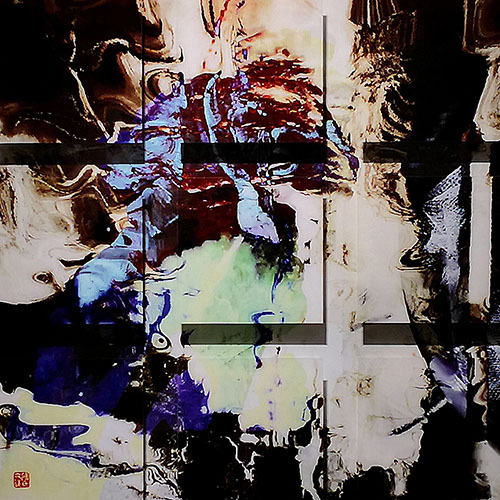
Occasional Moment
Fu Wenjun Digital Pictorial Photography 2017-2018

Sit and Watch the Clouds Rise
Fu Wenjun Digital Pictorial Photography 2017-2018
BIANCOSCURO RIVISTA D’ARTE
ISSUE ART BASEL HONG KONG MARCH 2019
Fu Wenjun
Nuovi orizzonti per la fotografia contemporanea
“Fu Wenjun abbraccia una gamma di forme d’arte, combinandole in opere uniche e monumentali che vanno oltre il semplice atto di registrare un’immagine fotografica.”
Continua nella sua ascesa verso la consacrazione nel panorama mondiale dell’Arte che conta, imperterrito svela, giorno dopo giorno, nuovi traguardi della sua personale ricerca stilistica e concettuale. Raccontare Fu Wenjun non è mai stato semplice, le sue opere sono sempre, semplicemente, esteticamente perfete, calibrate e armoniche, e proprio questa perfezione matematica inganna la percezione emozionale ed indagatoria. La tecnica da lui create ed utilizzata la conosciamo già Digital Pictorial Photography, ma non possiamo fermarci al tecnicismo, dobbiamo indagare a fondo per comprendere prima cosa ha portato Wenjun a mettere apunto la sua personale cifra stilistca. Perchè ha sentito il bisogno di amalgamare le diverse discipline? Non è solo una questione di ricerca artistica, Fu Wenjun ha avuto una forte influenza dalla tradizione della sua culture, nonstante la sua propensione alla “ribellione” non può allontanarsi dal suo intimo.
Ed ecco che comprendiamo quanto sia il suo stesso essere ad essere “mescolato”:tradizione artistica cinese, pittura e segni della sua terra, visceralmente uniti alla più avanzata tecnica fotografica. Le opere di Wenjun rispondono a chi si chiede se esista ancora un valore artistico nella fotografia, ormai banalmente fruibile da chiunque. Le sue creazioni, con una base digitale, sono uniche ed inimitabili, nello stile dello scatto di partenza, nel segno pittorico, nella luce hanno raccolto e che rilasciano all’ambiente circostante. L’eleganza indiscutibile, affascina e coinvolge, portandoci, anche solo per un attimo, nel suo personale mondo.

East Wind Blew again Last Night
Fu Wenjun Digital Pictorial Photography 2017-2018

Soft Hand
Fu Wenjun Digital Pictorial Photography 2017-2018
0 notes
Text
Fu Wenjun:Critical Analysis
By Timothy Warrington — — International Confederation of Art Critics
From a layman’s perspective, photography is all too often seen as a tool with the sole purpose of documentation and, unfortunately, its extreme and sophisticated creative potential can occasionally be overlooked or even forgotten; Fu Wenjun is an artist actively concerned with creative attitudes and stereotypes who wishes to elevate photography through a process of thought and execution. In fact, his dynamic artworks explore, challenge and define the boundaries of digital art, photography and self-expression via a conceptual journey that is at the heart of his artistic process. In his most recent collection he has developed an intriguing and unique style that he has named ‘Digital Pictorial Photography’. These artworks adapt and distort the viewer’s perception, creating intense intrigue and inviting the passive observer to ponder the subconscious messages that are intrinsically contained within each piece whilst, simultaneously, conveying a treasured personal sense of the artist’s inner self.
Wenjun’s ‘Digital Pictorial Photography’ conceptions are alive with movement, intense character and comprehensive personality. The complex structural elements they possess lead the spectator’s eye deep into each enthralling detail while the fluidity of the forms and shapes often mask the image of a hand, face or even animal disguised within the artwork. These hidden intricate facets combine to assemble an arrestingly compounded formation in thoroughly captivating pieces that encourage the viewer to investigate and carefully analyse each aspect. This contemporary artist flawlessly employs his process, which incorporates multiple exposures and culminates in an intensely rich, layered opuses that conjure images of Man Ray’s rayographs produced without a camera when considering their shared experimental approach to the delicate relationship between light, balance and aesthetics. Wenjun’s creations are often defined as rebellions and its purely informational attitude towards photography. His stunning compositions are thought provoking and require substantially more from the viewer than simple observation of their beauty as profound dimensions of the mind are ceaselessly stimulated by Wenjun’s work.
In Wenjun’s collections ‘Digital Pictorial Photography 1, 2 and 3’, he uses extensive imagery of traditional sculpture, predominantly originating from the Western hemisphere, which suggests an inspiration or reaction to artists such as Michelangelo and Donatello, or indeed to the entire Renaissance period. Wenjun’s conceptual photography inspires deep reflection in regards to the relationships that exist between different cultures in the modern age of globalisation; he seamlessly juxtaposes ancient artforms with contemporary styles proving he possesses the undeniable capacity to move the viewer to contemplate specific issues whilst successfully bringing together a cohesion of old and new artistic techniques enriched and connected by his fresh perspective. Wenjun masterfully utilises his artform as a fluent language through which to communicate his passionate commentary on urbanisation on modern life.
Wenjun’s digital photography stems from diverse influences, including a fundamental understanding of classical European art, as is exemplified in ‘The Showy World’ from his Photographic Narrative collection. The statues presented in this piece have been expertly manipulated in negative and are surrounded by strong, eye catching colours and exuberant, expressive forms. Wenjun’s art is awash with vibrant energy; he frequently uses striking red hues and harsh black tones which, combined with a distinct sense of movement, provide inextricable links to traditional Chinese art such as that of Zhang Daqian. Wenjun visually contorts themes and motifs in order to emblematically express the narrative of the profound effect that rapid societal change has on Chinese towns. His message is further solidified by means of an integrated web of academically utilised symbolism that connects the viewer to the eloquent sense of the artist’s honest and full self expression captured in each artwork.
Whilst Wenjun’s style is incredibly unique, upon close analysis it is possible to draw comparisons with the photography of Barbara Kasten and Maya Rochat by analysing at their vivid use of colour and bold forms. Kasten shares the use of three dimensional objects and statues that are artistically altered through the lens of the camera to conceive a distinct conceptual creation with new perspective and purpose. A further influence of expressionism can also be detected in Wenjun’s individual approach to form and shape; he and Lee Krasner share deep philosophical ideals that are powerfully demonstrated through their daring yet elegant interpretation of line and shape.
There is a rare aura of freedom radiating from Wenjun’s photography who, through his artistic processes, achieves a wonderful symbiosis of beauty and provocative message rendering his works a true delight both to observe and to contemplate. Wenjun’s creativity reflects the sheer magnitude of his affinity to his medium, he demonstrates an impeccable ease in expressing challenging thoughts and concerns through his camera and via his skilled photographic manipulation. His remarkable innovation consistently catalyses a relentless search to develop new artistic methods through which to articulate his fervently heartfelt and sincere thoughts that unite to establish his philosophies in regard to a ceaselessly expanding world.
0 notes
Text
Fu Wenjun: Tradizione o globalizzazione?


Daniela Malabaila
Artista contemporaneo cinese, figlio degli anni cinquanta, Fu Wenjun si è ormai affermato nel mondo per le sue particolari opere fotografiche, immagini multiple e moltiplicate dalle prospettive multidimensionali.
La sua passione per l’arte non l’ha fatto femare al mezzo fotografico, ma l’ha spinto a cercare altri mezzi per esprimersi, dalla classica pittura ad olio, alle grandi installazioni contemporanee.
Il tema di fondo delle opere di Wenjun è sicuramente da ricercare nella storia nella cultura orientale, di come cambia rapidamente la società e di come interagisce con le culture occidentali. Come interagisce l’antica tradizione orientale con la globalizzazione occidentale? Come riesce a trovare connessioni che non intacchino il patrimonio tipico, ma che al contempo non facciano rimanere indietro l’evoluzione?
Lui esprime il suo parere attraverso le sue opere, cromie forti e prospettive fuorvianti riescono a trasmettere l’inquietudine del nostro tempo.
Ecco che troviamo dunque in Fu Wenjun, se non le risposte definitive, almeno un appriccio serio e ragionato sul tema, l’arte come mezzo per definire la società del momento, l’arte per ricordare la società del passato.
文 / 意大利艺术杂志《黑白》主编:达妮埃拉·马拉巴依拉
中国当代艺术家,生于20世纪50年代,傅文俊在世界各地得到人们的赞赏,特别是他的摄影作品,那些有着多维视角的多重、多样的图像。
他对艺术的热情没有仅仅停留在摄影之中,他也在探索用其他的方式表达自己,从古典油画到大型的当代装置作品。
对傅文俊作品背景主题的探究需要走入东方文化历史,了解他所生活社会的变革和它如何与西方文化碰撞融合。也就是说,如何融汇古老的东方文明与西方世界文化?如何找到在发展中如今难以立足的非物质文化遗产与当今时代和社会的连接?
他通过自己的作品表达观点,浓郁的色彩和独到的视角传达出我们这个时代的焦躁不安。
总之,傅文俊在作品中即使没有明确的回答,至少也以严肃而合乎逻辑的方式回应了一个观点:艺术是定义当下社会的一种方式,艺术是为了记住社会的往昔。
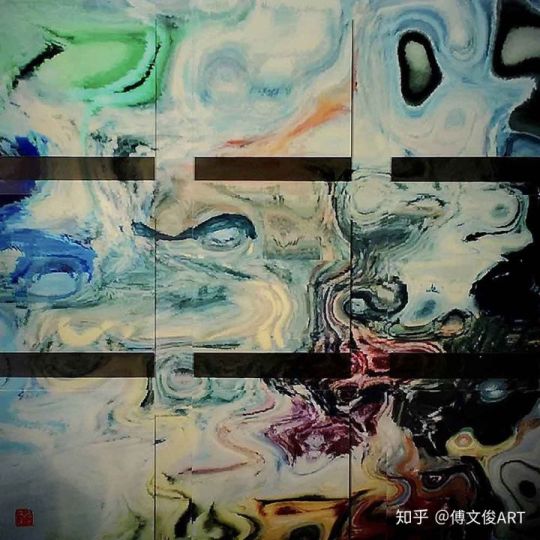
《重回伊甸园》 傅文俊 数绘摄影 100x100cm 2017-2018

《八点三十分》 傅文俊 数绘摄影 100x100cm 2017-2018
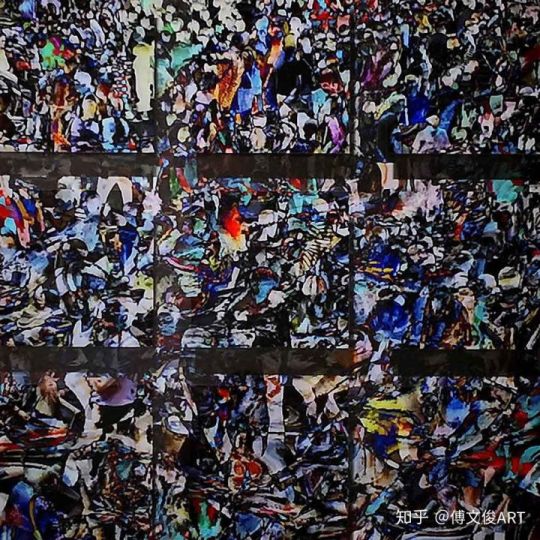
《三甲医院》 傅文俊 数绘摄影 100x100cm 2017-2018

《他们看见了什么》 傅文俊 数绘摄影 100x100cm 2017-2018
0 notes
Text
Fu Wenjun’s Digital Pictorial Photography
By Grishma Khodaria NY-ARTNEWS
December 15, 2018
Fu Wenjun’s concept of digital pictorial photography takes us into rhythmic, flowing, dancing and bright elements of fine art, which creates aesthetic pleasure while viewing his art pieces. Contemporary artist Fu Wenjun creates most of his artworks through the art media of conceptual photography, installation, sculpture and oil painting, and has put forward the concept of "digital pictorial photography". He gives a new direction to the world of digital art. He does not majorly regard photography as a regular photography medium. According to him it has a close relationship with fine art. The role of aesthetics, knowledge of form, elements, as well their placement, along with his knowledge and study of art history of almost all time periods, be it European, Chinese, or American art, all together have embarked his journey leading towards a successful artistic career.
The artist shows his concept of Digital Pictorial Photography in the way he presents his photographs, for example: in one of his series, they look like the Chinese ink paintings or even bright paints on canvas, which is very soothing. That is due to the way he photographs his elements. His artistic collection of photography looks like a fusion of macro shots with some shots from a distance, as if they have been combined together to create an effective composition. All this somewhere connects to his fine art education and learnings, as if it has been inculcated into his artworks. It looks like a natural scene where nothing is static; a movement can be felt as if the images are still moving while on display. The beautiful digital art pieces create the illusion of flowing ink in water, which is like a natural rhythm.
Since the photographs have not been represented directly from the camera, Fu Wenjun goes through a deep thought process where the question comes: What to represent? and How would the elements and visuals impact the work, first for the artist and then ultimately for the audience. So here at this point he puts in a lot of efforts to decide what subject he wishes to focus on and what is the purpose behind each creation of his digital art pieces. Accordingly, Fu Wenjun uses the images which he collects from traveling or from any other of his photography. This is the time when he plays with the theme, form and content. It is impressive to see Fu Wenjun's usage of computer software for his photographs. The most interesting part here is that the art pieces still look natural, it is because of the artistic usage of the combination of different elements like line, color, tones and space division, which he combines in an aesthetically appealing way.
Fu Wenjun pays great attention to the whole process with perfection right from the point of the creation of the idea until its execution which is perfectly mounted and framed. Each and every step is set to a high standard. He possesses a great knowledge of execution and presentation of fine art in a pleasing way, while with no doubt he can be called a perfectionist. “My photographic works are possibly not like photographs. I call it Digital Pictorial Photography works, because I aim at exploring to place photography art in dialogue with other art media, like Chinese painting, oil painting, print, sculpture etc. As a result I widen the boundary of photography art in the current digital age,” says Fu Wenjun in describing his art. He also talks about the crucial process where he creates a planned and thoughtful idea to be executed, “I found photography as art has much to be explored, to be connected with different art media in various ways. I have had a large number of photos taken in my traveling or even daily life. They are raw materials collected and at my hand to use for my experimentation. What I do is to think over and over again how to express all this in my works, and to select elements that could contribute to the overall presentation.”
Fu Wenjun also talks about his inspiration of art from the Chinese artists Bada Shanren and Shi Tao. “I like very much Bada Shanren, Shi Tao who provide me deep understanding of ink painting and Chinese traditional art.” As we discuss further about oil painting, Fu Wenjun's says that most of the inspiration comes from the time period of Monet and Pissarro. His understanding of art has not just been restricted to the 19th century art movement. “Among the Western artists, I love the impressionists, like Monet, Pissarro, who make me look closely at the oil painting history as well as the art history before and after them.”
He has gained numerous art awards. His artworks have been collected by eminent art collectors and organizations like Museu Europeu de Arte Moderno, National Art Museum of China, Today Art Museum, Tokyo Metropolitan Art Museum, Kennedy Family, World Council of Peoples for the United Nations, Dazu Grotto Museum, Chongqing Art Museum and Guangdong Museum of Art to name a few. He has been actively participating in numerous solo and collective exhibitions in many countries around the world among which are China, USA, UK, Korea, Italy, Germany and Russia. It is Fu Wenjun’s consistent efforts which naturally attract the audiences, art collectors and organizations around the world which have a lot of excitement to see something new, as each time he creates new concepts and executes them quite artistically.
(https://www.ny-artnews.com/single-post/2018/12/14/Fu-Wenjun%E2%80%99s-Digital-Pictorial-Photography)
0 notes
Text
2018傅文俊和他的数绘摄影
摄影长期以来都被认为是一种记录现实,讲述故事的手段,在这样的视角之下,摄影天生拥有的艺术创造潜力被压抑了。傅文俊提出的“数绘摄影”作为一种新的摄影艺术风格和流派,他要让摄影做回摄影,展现自身巨大的艺术魅力,探索摄影和绘画、雕塑等其他艺术形式之间的对话、补充与延展,在当下的数码时代拓展摄影的边界。
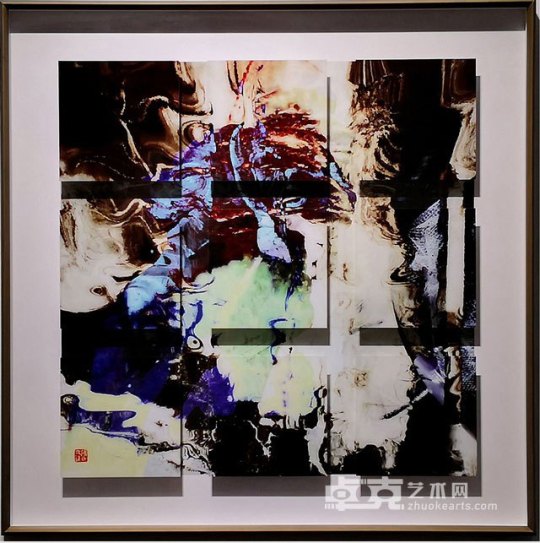
《不经意之间》傅文俊 数绘摄影 100x100cm 2017-2018
“数绘摄影”的艺术理念与和视觉传达方式不同于以往的摄影,中国艺术的部分特质与非中国艺术的特质并存其中,比如散点透视与焦点透视之间的冲突,水墨晕染与色彩交错相互渗透,气韵生动与主观表达的有机结合。将西方古典绘画讲究光影调、冷暖色调相融的表现技法融合于以光作为最基本元素、讲究光影调、黑白与色彩的摄影影像之中。
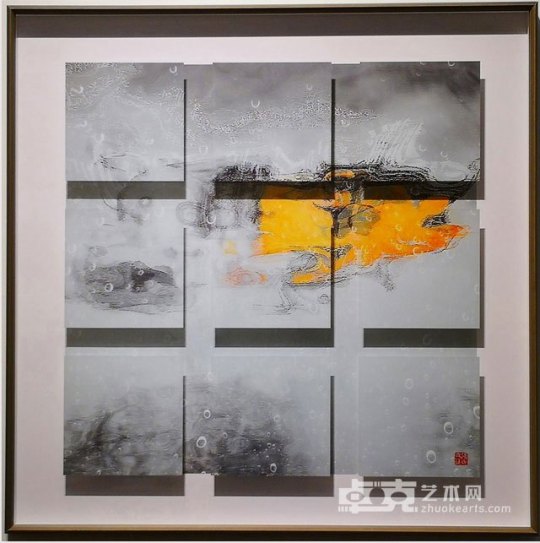
《大珠小珠落玉盘》傅文俊 数绘摄影 100x100cm 2017-2018
在傅文俊看来:“艺术是对这个无比广阔且丰富多姿的世界的一种反映,同时也是我个体生命经历和思考的一份吐露,艺术家可以借助一切熟知的媒介把它们表达出来,而我选择了将摄影同绘画结合起来。通常,人们认为这不同艺术形式有着不同的美学追求,摄影追求客观真实(尤其是纪实摄影),而绘画追求生动再现。长久以来,我一直从事艺术摄影,将摄影作为一门艺术来对待,而不仅仅是一个记录工具,注重当代艺术中强调的观念表达和多重指涉。因此,在我看来,摄影与绘画、雕塑绝非势不两立的敌人,甚至可以是相互借鉴的挚友。‘数绘摄影’就是这种艺术思考的产物。我认为,只要是我的艺术表达所需要的,我就会在摄影艺术创作中,有机地融入绘画性、雕塑性的视觉元素,色彩质感、生动美感。通过‘数绘摄影’虚实交织的图像和多种艺术形式的相互跨越,我希望赋予观者更多诠释和感知的自由,在作品、观者之间搭建起不同寻常且极具活力的关系,因为对艺术作品的认知绝不仅仅只有一种观看方式,对世界的认知更是如此。”

《迪拜的鱼》傅文俊 数绘摄影 100x100cm 2017-2018
傅文俊对摄影艺术的创新与他对艺术史的感悟和思考是分不开的。他想,在摄影术发明之时,它凭借细腻、精准、快捷捕捉事物的能力让古典写实绘画顿时黯然失色,让绘画界陷入恐慌,刺激绘画寻求新的发展方向;立体主义、超现实主义、抽象表现主义等等多样的绘画流派让20世纪的艺术舞台生机勃勃。如今,摄影经过一百多年的发展,应该有更大的新突破、新尝试,而不仅仅停留在对摄影技术本身的钻研上。“在我的摄影创作中,我希望极大地发挥数码后期处理的优势,让作品承载对当代社会思考的同时,能够展现出绘画,特别是中国水墨写意画的美感、意趣。它看起像画,实则是一种相当大胆的摄影创新,很另类,大概还没有其他人在做。我希望能向更多的人展示这样的摄影,这样的风格也不失为摄影艺术发展的一种方向。”
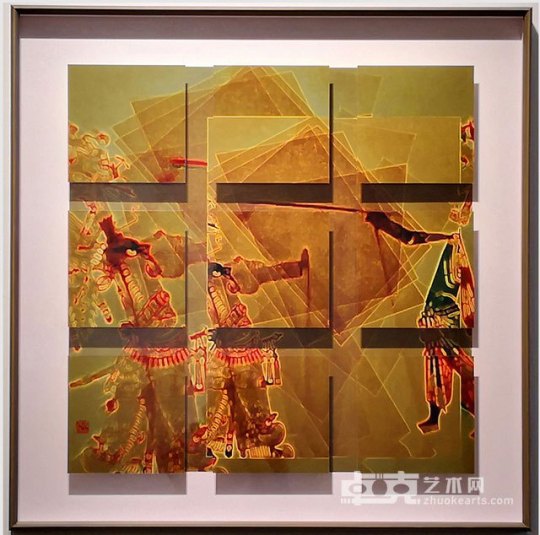
《过去未来》傅文俊 数绘摄影 100x100cm 2017-2018
2018年傅文俊创作的数绘摄影作品更加巧妙地在摄影媒介中对多种艺术形式加以融合,在三度空间层面探讨摄影,从多个向面分割空间、与时刻变化的真实光影游戏。今年美国戴尔瑞艺术中心推出他的个人展览《这是摄影吗?——傅文俊数绘摄影展》,将艺术家的数绘摄影及他对历史、文化、人文议题的种种思考带去了更远的国度。此外他还受邀参加万国双年展、基安恰诺国际艺术双年展、萨莱诺当代艺术双年展等多个国际艺术双年展;今年创作的数绘摄影作品在2018棕榈滩国际艺术博览会、艺术纽约、影像上海艺术博览会、香港典亚艺博、艺术迈阿密等国际重要艺博会上受到世界各地藏家的青睐。11月傅文俊还荣获被称为“视觉艺术奥斯卡”的“全球艺术奖”之“数字艺术”类别桂冠,得到阿联酋皇室成员、阿拉伯联合酋长国总统的之兄、阿布扎比酋长国艾因城市执政者之子H.H. SHEIKH SAEED BIN TAHNOUN BIN MOHAMMED AL NAHYAN的亲自颁奖。为即将来临的2019年,艺术家傅文俊已经忙碌起来,新年伊始他的个人展览《再次进场——傅文俊数绘摄影作品展》即将于1月16日-1月27日在重庆美术馆1号展厅举行,上百件数绘摄影作品将展示出傅文俊独创的摄影艺术流派其特有的学术价值和美学风貌。

《红酥手》傅文俊 数绘摄影 100x100cm 2017-2018
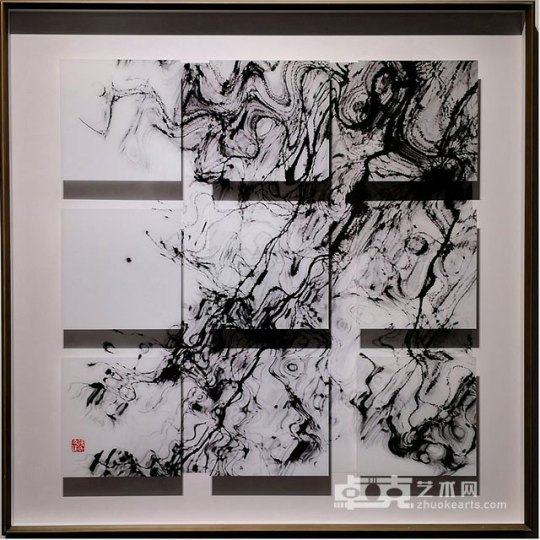
《空山新雨后》傅文俊 数绘摄影 100x100cm 2017-2018

《六月雪》傅文俊 数绘摄影 100x100cm 2017-2018

《路遥知马力》傅文俊 数绘摄影 100x100cm 2017-2018

《我们需要出口》傅文俊 数绘摄影 100x100cm 2017-2018

《无尽的思绪》傅文俊 数绘摄影 100x100cm 2017-2018

《小楼昨夜又东风》傅文俊 数绘摄影 100x100cm 2017-2018

《坐看云起时》傅文俊 数绘摄影 100x100cm 2017-2018
0 notes
Text
ARTNESS SYSTEM Interview with Fu Wenjun:Significant Contemporary Approach


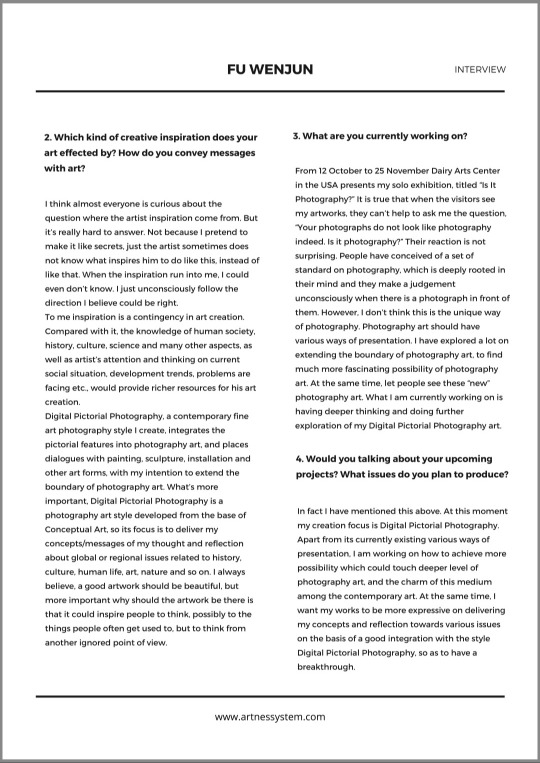
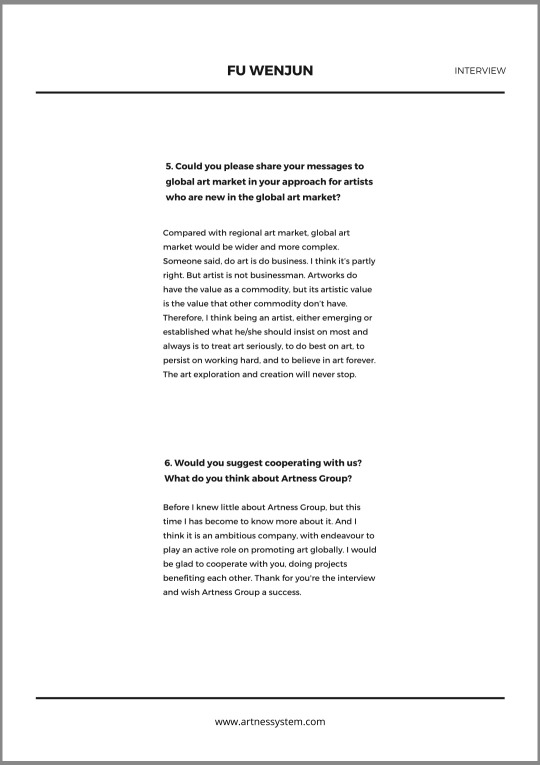
by Asya Sevdalinova Dzhankova
Fu Wenjun, Chinese contemporary artist, was graduated from Sichuan Fine Arts Institute. He creates principally through the art media of conceptual photography, installation, sculpture and oil painting, and has put forward the concept of "Digital Pictorial Photography".
Fu Wenjun’s works embody his thinking and reflection on many issues related to the Eastern and Western history, culture and humanity, including the relationship between different cultures in the age of globalization, the heritage of traditional Chinese culture in a rapidly changing society, industrialization and urbanization in Chinese cities.
He has presented solo exhibitions at the Museu Europeu de Arte Moderno (Barcelona), the National Art Museum of China (Beijing), the Old Summer Palace (Beijing), at the Today Art Museum (Beijing), at theUnited Nations Headquarters (New York), at the Guangdong Museum of Art (Guangzhou) and at other international art organizations. His works are exhibited at significant international exhibitions, such as the Triennale dell'Arte Contemporanea, the 1st Asia Biennial / 5th Guangzhou Triennial, the XVIII Bienal de Cerveira, NordArt, the collateral exhibition of Biennale di Venezia 2013, entitled Voice of the Unseen Chinese Independent Art 1979 / Today.
Hello Fu Wenjun. Congrats to being selected as an interview artist. Could you please talk about your art background? You already selected many collection and opened many solo shows in all around. Do you work with your team?
Hello, first of all thanks for your appreciation on my art, and I am honoured to be interviewed.
I have worked on photography art for more than 30 years, and in recent years I put forward the art style Digital Pictorial Photography, a new art language and art school. Now with the focus on Digital Pictorial Photography, my art creation does cross over several disciplines, including oil painting, sculpture, installation and others.
I believe art creation is absolutely subjective, some impromptu things happen always. I work by myself, without a team. I don’t like that commercial art products seemingly produced by a factory. Each piece of artwork should be unique.
Which kind of creative inspiration does your art effected by? How do you convey messages with art?
I think almost everyone is curious about the question where the artist inspiration come from. But it’s really hard to answer. Not because I pretend to make it like secrets, just the artist sometimes does not know what inspires him to do like this, instead of like that. When the inspiration run into me, I could even don’t know. I just unconsciously follow the direction I believe could be right.
To me inspiration is a contingency in art creation. Compared with it, the knowledge of human society, history, culture, science and many other aspects, as well as artist’s attention and thinking on current social situation, development trends, problems are facing etc., would provide richer resources for his art creation.
Digital Pictorial Photography, a contemporary fine art photography style I create, integrates the pictorial features into photography art, and places dialogues with painting, sculpture, installation and other art forms, with my intention to extend the boundary of photography art. What’s more important, Digital Pictorial Photography is a photography art style developed from the base of Conceptual Art, so its focus is to deliver my concepts/messages of my thought and reflection about global or regional issues related to history, culture, human life, art, nature and so on. I always believe, a good artwork should be beautiful, but more important why should the artwork be there is that it could inspire people to think, possibly to the things people often get used to, but to think from another ignored point of view.
What are you currently working on?
From 12 October to 25 November Dairy Arts Center in the USA presents my solo exhibition, titled “Is It Photography?” It is true that when the visitors see my artworks, they can’t help to ask me the question, “Your photographs do not look like photography indeed. Is it photography?” Their reaction is not surprising. People have conceived of a set of standard on photography, which is deeply rooted in their mind and they make a judgement unconsciously when there is a photograph in front of them. However, I don’t think this is the unique way of photography. Photography art should have various ways of presentation. I have explored a lot on extending the boundary of photography art, to find much more fascinating possibility of photography art. At the same time, let people see these “new” photography art. What I am currently working on is having deeper thinking and doing further exploration of my Digital Pictorial Photography art.
Would you talking about your upcoming projects? What issues do you plan to produce?
In fact I have mentioned this above. At this moment my creation focus is Digital Pictorial Photography. Apart from its currently existing various ways of presentation, I am working on how to achieve more possibility which could touch deeper level of photography art, and the charm of this medium among the contemporary art. At the same time, I want my works to be more expressive on delivering my concepts and reflection towards various issues on the basis of a good integration with the style Digital Pictorial Photography, so as to have a breakthrough.
Could you please share your messages to global art market in your approach for artists who is new in the global art market?
Compared with regional art market, global art market would be wider and more complex. Someone said, do art is do business. I think it’s partly right. But artist is not businessman. Artworks do have the value as a commodity, but its artistic value is the value that other commodity don’t have. Therefore, I think being an artist, either emerging or established what he/she should insist on most and always is to treat art seriously, to do best on art, to persist on working hard, and to believe in art forever. The art exploration and creation will never stop.
0 notes
Text
“艺术迈阿密”(ART MIAMI)作为美国佛罗里达州迈阿密历史最悠久的艺术博览会,始终在美国现当代艺术市场保持卓越地位,与世界范围内的顶级画廊合作,在全球范围内它被认为是购藏20、21世纪最重要艺术品的首选之地。
第29届“艺术迈阿密”于2018年12月4日-9日如期举行,中国当代艺术家傅文俊受邀参展,国际画廊BOCCARA呈现其最新数绘摄影作品系列《西藏飘来的风》。
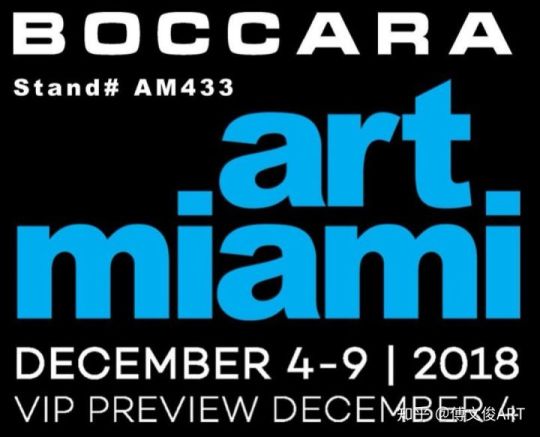
《西藏飘来的风》是艺术家傅文俊以其独创的艺术风格“数绘摄影”创作而成。他对摄影艺术的独到思考,另辟蹊径的创作方法,以新颖生动地展现出雪域高原令人赞叹的自然风光,以及迷人却鲜为人知的地区文化。在全球化席卷世界的今天,艺术家让人们领略这一片“与世隔绝”的仙境及其独有文化,引发人们对同质化与多元化命题的思考。

傅文俊数绘摄影作品《西藏飘来的风》

“艺术迈阿密”展览现场
迈阿密当地艺术媒体“迈阿密艺术现场”对傅文俊和他的艺术创作予以关注,在报道中写道:“傅文俊是一位革新的艺术家,他的作品反映了东西方文化中的多种二分法,包括全球化时代的文化观念,快速变化社会下的中国传统文化,以及工业化和城市化的影响。通过利用他称之为‘数绘摄影’的独特创作过程,傅文俊能够将来自东西方的美学融汇在一起,创造出能够超越类别和传统的新艺术。他的新系列《来自西藏的风》是‘艺术迈阿密’上不容错过的作品。”
与此同时,傅文俊与韩国艺术家HyunAe Kang的双个展《平和中的混乱》正在BOCCARA位于布鲁克林的画廊中进行,展览从12月1日持续到明年1月1日,傅文俊的《西藏飘来的风》全系列作品、《人间四月》、《关雎》、《六月雪》、《过���未来》等多件数绘摄影作品均在展出之列,对当下诸多人们关心的议题提出了他具有东方哲思的观点与看法。(陈丹)
0 notes
Text
傅文俊的跨界式多元艺术创作历程
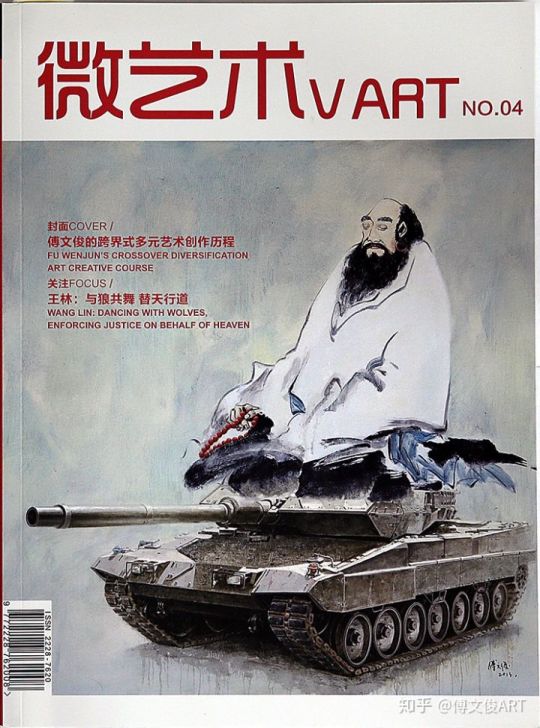


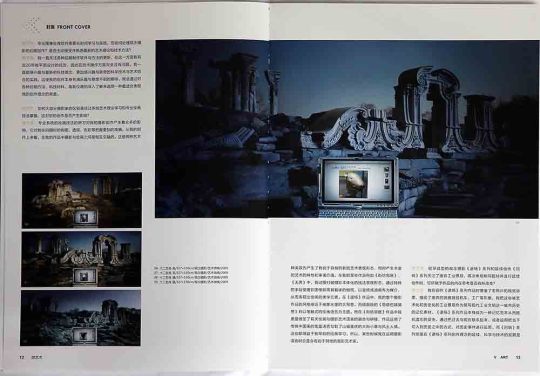

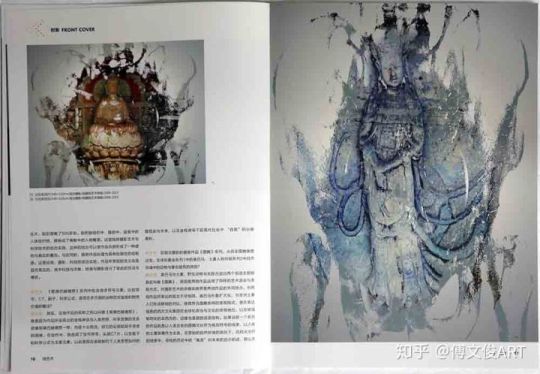

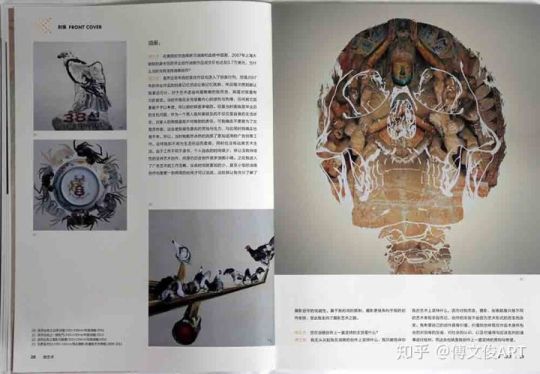
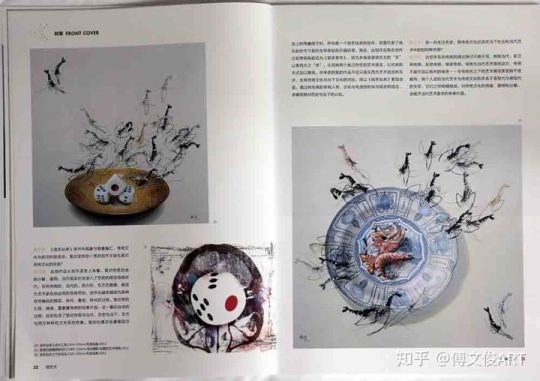

艺术形式跨界
从最初的纪实摄影、中国画创作和美院学习油画,再到观念摄影,傅文俊老师对艺术知识的系统学习与多年创作经验积累,促使其多元化创作方式和内部主体思想形成。
摄影:
微艺术:对艺术最初的自身认识和体会?何时开始摄影创作,把摄影作品作为艺术品看待?傅文俊:使用照相机是在70年代末期的时候,那个时候也就是工作需要.为宣传工作拍一些纪实性的照片。后来我在四川美术学院攻读的是油画专业,我自然也是因为钟情于艺术的美学与感性魅力而进行了艺术的专业训练。当时我习惯于风景写生,写实与抽象兼做。毕业后先后从事了平面设计与大型广告绘制和广告创意策划工作。这一时期的摄影基本上是为绘画创作与广告创意收集器材。虽然广告创意策划也属于艺术的范畴,但从实质上讲,它不能像绘画和摄影那样,具有完全的艺术性与学术性。对艺术的热爱时刻牵动着我的心.所以一有时间我总是想象起画笔,进行艺术创作。由于平日工作繁忙,根本无法完成大时间块的绘画过程,所以我选择摄影这一瞬时性的艺术语言,这样我可以利用工作之余完成我的艺术梦想。而且,我觉得无论是绘画还是摄影,他们都是相互联系的,两者的创作过程都承载着艺术家的社会身份、价值取向与自身的内在体验。所以近三年我重新开始进行一些绘画类的艺术实验,创作了一批油画作品。
微艺术:从风光摄影、新闻摄影、纪实摄影到观念摄影,您经历了怎样的过程?
傅文俊:一开始从事摄影艺术基本上就是以纪实摄影为主,伴随着对艺术理念的研究,我的创作日益的转入到观念摄影的范畴。因为观念摄影的美学特点能够更加准确的呈现出我想表达的创作思想。大家都知道,观念摄影是伴随着作为当代艺术范畴的观念艺术在中国的兴起而出现的。它既不是一个概念,也不是一种主义,而是艺术家将思维水平和感悟能力付诸于画面所承载的内客。观念摄影相对于新闻摄影或者纪实摄影而言,更具有问题的针对性,可以更好的与当代文化、社会现实、权利意识发生联系。从摄影艺术的发展史上来看,艺术家也往往是从新闻摄影、纪实摄影与风光摄影极端忠实于客观客体后,逐步转向采用后期制作以期达到某种特殊效果以及观念的表现。
微艺术:在摄影领域您选择了多元化、跨界式的创作、实践原因?
傅文俊:摄影对于绘画、雕塑等艺术形式而言,属于一门年轻的艺术门类,尤其是观念摄影更是伴随着当代艺术的发展而出现的。由于摄影艺术的平面性与精致性,再加之摄影所赖以生存的科技机械都带有一定的局限性,不能像装置、影像以及多媒体艺术那样生动与多变。摄影本体语言的探索也渐渐走向瓶颈,所以我僦在思考如果将摄影与科学技术充分的融合,达到的效果会有怎样优势与不同?众所周知,由于视觉文化的转型,传统的艺术(绘面、摄影)在跨学科和运用科技力量的方便有所突破。大众传媒的科技革新和新媒体艺术在跨文化传播体系中,实现了宏观与微观的意识操控。而我的作品在不跨越摄影概念的同时无限的接近于新媒体艺术,即主要是以数字技术为基础,呈现具有网络、传播互动与虚拟特征的艺术形态。由于后现代主义研究的非精英化倾向,视觉文化开始转向通俗文化。这—方面我是希望可以在视觉上给观众以新奇感与惊艳感,另—方便在艺术的体验上给予观众更多的互动性与丰富性。我希望通过这种多元的、跨界的艺术实践丰富摄影艺术本身并缩短艺术家与观众以及作品与观众的距离。

《图腾II》No.1 傅文俊
微艺术:经过多年的摄影经验积累,观念摄影创作过程中是否还会遇到困难?
傅文俊:艺术创作本身就是一个不断遇到问题与解决问题的过程,当你不能找到面对与解决问题最佳方式的时候自然会觉得自己遇到了困难,但是艺术不能急功近利,而是要在循序渐进中不断的发展。
微艺术:专业图像处理软件需要长时间学习与实践,您如何处理观念摄影的后期创作?是否主动接受并熟悉最新的艺术理论和技术方法?
傅文俊:我一直关注各种后期制作软件与方法的更新,在这一方面我有近20年傲平面设计的经历,因此在技术操作方面完全没有问题。我一直都感兴趣与最新的科技理念,更加感兴趣与新奇的科学技术与艺术结合的实践,这使我的创作本身充满乐趣与意想不到的期待。我会通过对各种后期方法、科技材料、高新仪器的深入了解来选择一种最适合表现我的创作理念的渠道。

《图腾II》No.2 傅文俊
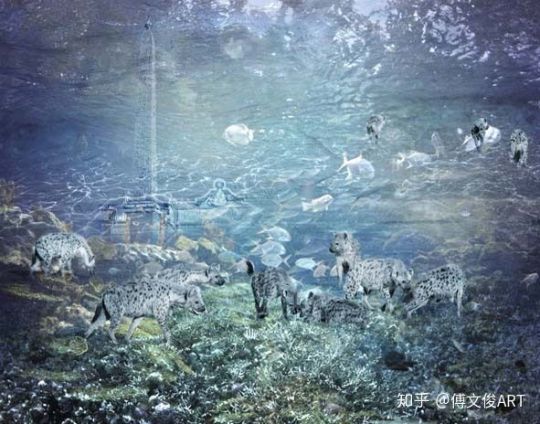
《图腾II》No.3 傅文俊
微艺术:您和大部分摄影家的区别是经过系统艺术理论学习和专业绘画技法掌握,这对您的创作是否产生影响?
傅文俊:专业系统的绘画技法的研习对我的摄影创作产生着众多的影响,它对我在拍摄时的构图、透视、色彩等把握更加的准确。从我的创作上来看,在我的作品中摄影与绘画之间是相互交融的。这使两种艺术种类双方产生了有别于自身的新的艺术表现形态,同时产生丰富的艺术的特性和审美价值。在我的某些作品例如《街坊邻居》、《无界》中,我试图打破摄影本体化的技法表现形态,通过特殊的手段使摄影图像脱离其载体的相纸,以宣纸或油画布为媒介,从而表现出绘画的美学元素。在《退场》作品中,我的整个摄影作品的风格接近于抽象水墨的大写意。而镜面版的《哥德巴赫猜想》则以笔触式的绘画语言为主题。而在《街坊邻居》作品中我更是做足了有关绘画与摄影艺术语言的融合与拼接,作品运用了传统中国画的笔墨语言勾勒了山城重庆的大街小巷与风土人情。这些都得益于我早前的绘画学习。所以,某些时候我在运用摄影语言时总是会有别于其他的摄影艺术家。
微艺术:较早成型的观念摄影《退场》系列和延续创作《回响》系列关注了废弃工业景观,再次审视相同题材并进行延续创作时,您所赋予作品的内在思考是否有所改变?
傅文俊:我在创作《退场》系列作品时借鉴了老照片的视觉效果,描绘了废弃的锈痕斑驳机车、工厂等形象。我把这些被艺术化和历史化的工业景观作为撰写现代工业文明这一城市历史的记忆素材。《退场》系列作品本身成为一种记忆范本从而抵抗遗忘的妥协。通过把过去与现在联系起来,或者运用把当下切入到历史之中的方式,对历史事件进行反思。而《回响》系列则是在《退场》系列创作理念的延续,科学与技术的发展是无止境的,中国的历史总是以毁灭的方式更替向前,更高生产力的出现使无数工厂、设备被淘汰。在我的作品中无论是老旧的机车还是铁轨,无论是车间还是厂房,都已消磨了往昔的炽热与辉煌,唯一保留的就只有国家理想主义与英雄主义的回响。这是我当时创作这些作品时的心中所想,你若问现在思想是否有变化,答案是肯定的,随着我对社会、对自我、对艺术语言认识的不断改变,思想自然随之改变,因为每个人都活在当下。所谓当下,就是有别于昨天,但是思想的脉络是外延的丰富与内涵的加深,而非相悖。

《图腾II》No.4 傅文俊

《图腾II》No.5 傅文俊
微艺术:2010年您《十二生肖》、《万国园记》两个系列摄影作品,所衍生出《圆明园南移1400公里》展览中的行为艺术,融入了现成品、动态影像、装置作品,这种多元化、跨界式创作的动机和寓意?
傅文俊:在“圆明园南移1400公里”展览中,我仍以圆明园这一主题的阐释作为线性创作的起点,并将能隐喻圆明园惨遭毁坏的解说石与《十二生肖》系列作品相互配合,与正在开展的世博会形成鲜明比对。除此之外,展览融入了许多现成品、动态影像与装置作品,例如,表达东西方文化的中国昆剧《桃花扇》和西方经典之作《茶花女》的影像播放,麻将桌的装盛行为作品等等。我之所以这样安排自己的展览,并非完全基于对跨界的尝试一而是这种集摄影、影响、装置、行为为一体的展览模式能够更加全面的诠释我的作品。许多行为艺术家把摄影作为记录作品观念的载体,在我的展览中行为与装置成为我摄影作品的解说。
微艺术:《他心通》、《无界》、《幻化》系列把宗教与现代科技CT造影技术相结合,是您在摄影与绘画的跨界创作方式的沿用发展,最初的创作思路和内在思考?
傅文俊:在这三组摄影作品中我运用了“造影”的医学方式,也就是医学临床所使用的造影显影技术,它通过磁渡对人体的声像模拟出了人体的影像。为了获取第一手的资料,我通过各种方式搜集X光片,为了有真实融入的效果,我还亲自在医院拍自己的X光片,前后搜集了500多张。我把脑组织中、胸腔中、盆骨中的人体组织物,置换成了佛教中的人物雕塑。这是我将摄影艺术与科学技术的结合实践,这样的结合可以使作品内部形成了—种虚构与真实的叠加。与此同时,我将作品处理为具有绘画性的绘制感。这是绘画、摄影、科技的成功实验。作品所表现的含义也是显而易见的,其中科技与宗教、.绘画与摄影进行了彼此的互设与博弈。
微艺术:《歌德巴赫猜想》系列中包含很多符号元素,比如货币、CT、骰子、科学公式,是否在多方面的诠释您对金钱和物质价位的看法?
傅文俊:其实,这组作品的名称之所以叫做《哥德巴赫猜想》,就是因为作品所呈现出的金钱神话与人类思想、科学发展的关系就像哥德巴赫猜想一样,内容十分简洁,但它的证明却异乎寻常的困进。在创作中,我选用了货币符号、头部CT片、以及救子和科学公式为主要元素。以此表现在金钱制约下人类思想如何把握现实与未来,以及金钱诱导下后现代社会中“自我”的分崩离析。
微艺术:您观念摄影的最新作品《图腾》系列,从历史图腾角度出发,主体形象由系列1中的奥巴马、土著人转向到系列2中自然环境中的动物与著名建筑的原因?
傅文俊:奥巴马与土著、野生动物与名胜古迹这两个创造主题部具名叫做《图腾》,原因是两组作品运用了同样的艺术语言与表现方式。对摄影艺术的多媒体跨界是两组作品的共同特点。但两组作品所表达的观念不尽相同,奥巴马形象扩大化,与非洲土著人们形成鲜明的对比,使其符合图腾崇拜的表现程式,意在表达强势的西方文化集团在全球化政治与文化的领导地位,以及被强制同化的非西方的、边缘与底层的话语结构。如果说前一个系列的作品我是以人类古老的图腾文化作为视觉符号的线索,以人类的土著族裔作为主体,在原始的自然环境的烘托下,在时光交织的线索中,寻找的历史中的“寓言”对未来的启示的话,那么在野生动物与名胜古迹系列中,我则尝试将镜头调转,从中探讨人类文化话语权下的时间纵向中人与环境的关系。转向于自然界作为视觉主体,在无限的空间格局中。面对虚化为背景的人类文明展开的又一重自然与人类的对话。

《图腾II》No.6 傅文俊
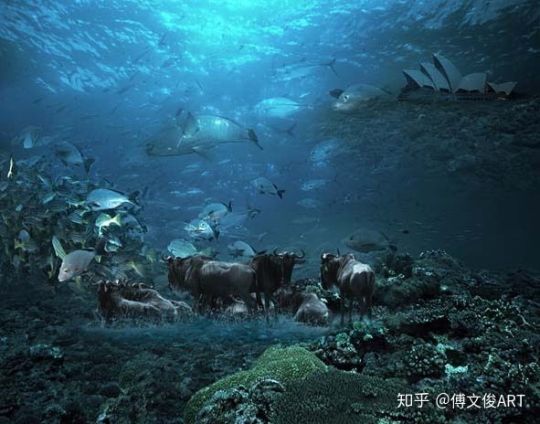
《图腾II》No.7 傅文俊
油画:
微艺术:在美院时您选择研习油画和选修中国画,2007年上海大剧院拍卖中您的毕业创作油画作品成交价也达到3.7万美元,为什么当时没有坚持油画创作?
傅文俊:虽然近些年我的某些作品也进入了拍卖行列,但是2007年的毕业作品的拍卖记忆仍旧让我记忆犹新,并且��次想到都让我激动万分。对于艺术造诣尚属稚嫩的我而言,那是对我最有力的肯定。当时作画完全凭借着内心的感性与热情,任何其它因素部不予以考虑,所以那时候是幸福的。但是当时面临是毕业后的生计问题,作为一个男人我所要顾及的不仅仅是自身的生活状态,对家人的照顾是我不可推卸的责任。可我确实不愿意为了交易而作画,这会使我背负莫名的苦恼与压力,与此同时我确实也做不来。所以,当时我毅然决然的选择了更加适用的广告创意工作。这样我即不用为生活所迫而卖画,同时也没有远离艺术生活。由于工作不同于读书,个人自由的时间很少,所以没有持续性的坚持艺术创作,但是仍旧会创作很多油画小稿。之后我进入了广告艺术的工作范畴,业余时间就更加的少,甚至小型的油画创作也需要一到两周的时间才可以完成,这时就让我充分了解了摄影创作的优越性。基于我时间的限制,摄影更佳有利于我的创作安排,至此我走向了摄影艺术之路。
微艺术:您在油画创作上一直坚持的主旨是什么?
傅文俊:我无从谈起我在油画的创作上坚持什么,我只能告诉你我在艺术上坚持什么。因为对我而言,摄影、绘画都是只是不同的艺术表现手段而已,创作的宗旨不会因为艺术形式的改变而改变。我希望自己的创作具有价值,价值恰恰体现在作品本身所包含的对自身的反省、对社会的认识、以及对值得与应该批判的诸事进行批判,而这些也就是我创作上一直坚持的原则与希望。
微艺术:《信手拈来》系列中具象与意象融汇,传统文化与前沿科技结合,是在坚持您一贯的创作主旨也是对传统文化的叹息?
傅文俊:此组作品从创作语言上来看,是对传统自由的分解、挪用。当代现实社会进入了空前的视觉信息时代,任何传统的、当代的、西方的、东方的图像,都成为艺术家自由运用的信息符码,创作也越来越成为各种符号编码的提取、排列、重组、转化的过程。我坦率的引用、摘录、重复传统的经典片段,这一看似自由的过程,实则包含了我对传统与当代、历史与当下、东方与西方种种权力关系的权衡。就如杜桑在给蒙娜丽莎加上的两撇胡子时,并非是一个信手拈来的动作,而是代表了他在新时代下新的生存体验和价值标准。其实,这组作品我在创作之��想将其起名为《顺手牵羊》,因为本身就是借东方的“手”以牵西方之“羊”,从而将两个既已存在的艺术语言,以另类的方式加以展现。但考虑到我的作品不仅只是东西方艺术语言的互涉,也有传统文化与当下文化的对比,所以《信手拈来》更加合适。通过将经典的传统人物、文化与先进的时尚与现状的结合,来展现我对历史与当下的认知。
微艺术:您一向关注历史,那传统文化应该在当下社会和当代艺术中起到何种作用?
傅文俊:近些年有关传统的理论探讨不绝于耳,统即当代、前卫即传统、反思传统、继承传统、传统为当代艺术提供动力、传统不能不加以批判的继承……在传统名义下的艺术展览更是数不胜数传。我个人觉的当代艺术与传统文化的关系不是取代与被取代的关系,它们之间相辅相成,对传统文化的借鉴、挪用和分解,会赋予当代艺术更多的审美价值。
原文刊载于2013年No.04 《微艺术》
0 notes